Grandchildren of Victoria and Albert
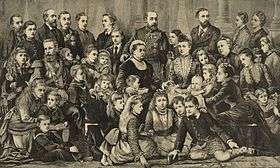
This is a list of the 42 grandchildren of the British Queen Victoria (1819–1901, queen from 1837, married 1840) and her husband Prince Albert (the Prince Consort, 1819–1861), each of whom was therefore either a sibling or a first cousin to each of the others. It also lists Victoria and Albert's 9 children and 87 great-grandchildren, as well as the spouses of those children and grandchildren who married.
Overview
Victoria and Albert had 20 grandsons and 22 granddaughters, of whom two (the youngest sons of Prince Alfred and Princess Helena) were stillborn, and two more (Prince Alexander John of Wales and Prince Harald of Schleswig-Holstein) died shortly after birth. Their first grandchild was the future German Emperor Wilhelm II, who was born to their eldest child, Victoria, on 27 January 1859; the youngest was Prince Maurice of Battenberg, born on 3 October 1891 to Princess Beatrice (1857–1944), who was herself the last child born to Victoria and Albert and the last child to die. The last of Victoria and Albert's grandchildren to die (almost exactly 80 years after Queen Victoria herself) was Princess Alice, Countess of Athlone (25 February 1883 - 3 January 1981).
Just as Victoria and Albert shared one grandfather (Duke Francis of Saxe-Coburg-Saalfeld) and one grandmother (Countess Augusta Reuss) in common, two pairs of their grandchildren married each other. In 1888, Princess Irene of Hesse and by Rhine, whose mother was Queen Victoria's daughter Alice, married Prince Henry of Prussia, a son of Victoria's daughter Victoria. Another of Alice's children, Grand Duke Ernest Louis of Hesse, married Princess Victoria Melita, a daughter of Alice's brother Alfred, Duke of Saxe-Coburg and Gotha, in 1894, but divorced in 1901.
Prince Albert, the Prince Consort (26 August 1819 – 14 December 1861), lived long enough to see only one of his children (the Princess Royal) married and two of his grandchildren born (Wilhelm II, 1859–1941, and his sister Princess Charlotte of Prussia, 1860–1919), while Queen Victoria (24 May 1819 – 22 January 1901) lived long enough to see not only all her grandchildren, but many of her 87 great-grandchildren as well. (Two of Victoria's 56 great-grandsons were stillborn, two more died shortly after birth, and one of her 31 great-granddaughters was born out of wedlock.)
Victoria, the Princess Royal and first child of Victoria and Albert (21 November 1840 – 5 August 1901), known as "Vicky", was not only mother to their first grandchild, Wilhelm II, she was also the first of Victoria and Albert's children to become a grandparent, with the birth in 1879 of Princess Feodora of Saxe-Meiningen, who was the daughter of Princess Charlotte (Queen Victoria's first granddaughter). She was also the grandmother of the last of Victoria and Albert's great-granddaughters to die, Lady Katherine Brandram (4 May 1913 – 2 October 2007), daughter of Vicky's fourth daughter, Queen Sophia of Greece. After Lady Katherine's death in 2007, the only surviving great-grandchild of Queen Victoria was Count Carl Johan Bernadotte of Wisborg (31 October 1916 – 5 May 2012), born to Crown Princess Margaret of Sweden, daughter of Victoria and Albert's third son, Prince Arthur, Duke of Connaught.
The death of Count Carl Johan Bernadotte marked the end of a generation of royalty that began in 1879 with the birth of Princess Feodora and included the British Kings Edward VIII and George VI, the Norwegian King Olav V, the Romanian King Carol II and the Greek Kings George II, Alexander I and Paul—as well as six uncrowned victims of political assassination, Earl Mountbatten of Burma (last Viceroy of India), Tsarevich Alexei of Russia and Alexei's sisters the Grand Duchesses Olga, Tatiana, Maria and Anastasia.
Queen Victoria's own death in January 1901 was preceded by the deaths of three of her own children (Princess Alice in December 1878, Prince Leopold in March 1884, and Prince Alfred in July 1900) and soon followed by the Princess Royal's death in August 1901. Aside from the four boys who died as infants, Queen Victoria had survived seven of her grandchildren:
- Prince Sigismund of Prussia (1864–1866) died of meningitis.
- Prince Friedrich of Hesse and by Rhine (1870–1873), a haemophiliac, fell from his mother's bedroom window and bled to death a few hours later.
- Princess Marie of Hesse and by Rhine (1874–1878) died of diphtheria.
- Prince Waldemar of Prussia (1868–1879) also died of diphtheria.
- Prince Albert Victor, Duke of Clarence (1864–1892) died of influenza.
- Prince Alfred of Edinburgh (1874–1899) shot himself with a revolver and died soon afterward.
- Prince Christian Victor of Schleswig-Holstein (1867–1900) died of malaria while on active service in South Africa during the Boer War.
Victoria, Albert and their children
Ancestors of Victoria and Albert
Victoria and Albert had one pair of grandparents in common, Francis, Duke of Saxe-Coburg-Saalfeld, and Countess Augusta Reuss of Ebersdorf, who were parents both of Albert's father Ernest I, Duke of Saxe-Coburg and Gotha, and of Victoria's mother (and Ernest I's sister), Princess Victoria of Saxe-Coburg-Saalfeld.
Duke Francis & Countess Augusta → Duke Ernest I → Prince Albert
Duke Francis & Countess Augusta → Princess Victoria → Queen Victoria
Another of Victoria's (but not Albert's) grandfathers was King George III, father of Victoria's father, the Duke of Kent, and his brothers King George IV and King William IV.
Marriage of Victoria and Albert
Queen Victoria (who had ascended to the throne on 20 June 1837 and been crowned on 28 June 1838) was married to Prince Albert on 10 February 1840 by William Howley, the Archbishop of Canterbury, in the Chapel Royal of St James's Palace in Westminster (London).[1] (Albert died fourteen-and-a-half years before Victoria was proclaimed Empress of India on 1 May 1876.)
| The Marriage of Queen Victoria and Prince Albert | ||||
| Name | Birth | Death | Marriage and children[2][3] | |
 |
[Alexandrina] Victoria, Queen of the United Kingdom of Great Britain and Ireland, later Empress of India |
24 May 1819 Kensington Palace, London |
22 January 1901 Osborne House, Isle of Wight |
Married 10 February 1840 at St. James' Palace, Westminster (London) 4 sons, 5 daughters (including British King Edward VII and German Empress Victoria); 20 grandsons (of whom 2 were still-born), 22 granddaughters (including British King George V, German Emperor Wilhelm II, Russian Empress Alexandra, and the Queens of Norway, Greece, Romania and Spain.) |
 |
Prince Albert of Saxe-Coburg-Gotha (The Prince Consort) |
26 August 1819 Rosenau Castle, Coburg (Germany) |
14 December 1861 Windsor Castle, Berkshire | |
Children of Victoria and Albert
Queen Victoria, at times, had contentious relations with her children. She had trouble relating to her children when they were young, some of this possibly owing to her own isolated childhood.[4] She also, occasionally, resented that they interfered with time that she would prefer to spend with Albert.[5] Both Victoria and Albert weren't above playing favourites with their children, and unfortunately did little to hide their favouritism.[5] Both Vicky and Alfred were the favorites of Albert, and Arthur enjoyed the favouritism of both his parents.[5] Victoria initially was jealous of the time that Albert had been spent with Vicky, but in her widowhood Victoria made Vicky something of her confidante,[6] and for her part, Vicky had accrued hundreds of letters from her mother, to the point that shortly before her death, she had them smuggled out of Germany by her brother's secretary, Sir Frederick Ponsonby.[7] Of her sons, Victoria had the most trouble with her eldest, the Prince of Wales, and her youngest, Leopold.[6] Amongst her daughters, Victoria clashed often with Louise.[6] She also had an awkward relationship with her second eldest daughter, Alice, who the queen, despite praising her thoughtfulness, also criticized her as being too melancholy and self-absorbed.[6] In her widowhood, Victoria expected Beatrice, who was only four when her father died, to remain at home with her, and only permitted to marry on the condition that she and her husband remain in England.[8]
| Portrait of Queen Victoria's family in 1846 by Franz Xaver Winterhalter |
|---|
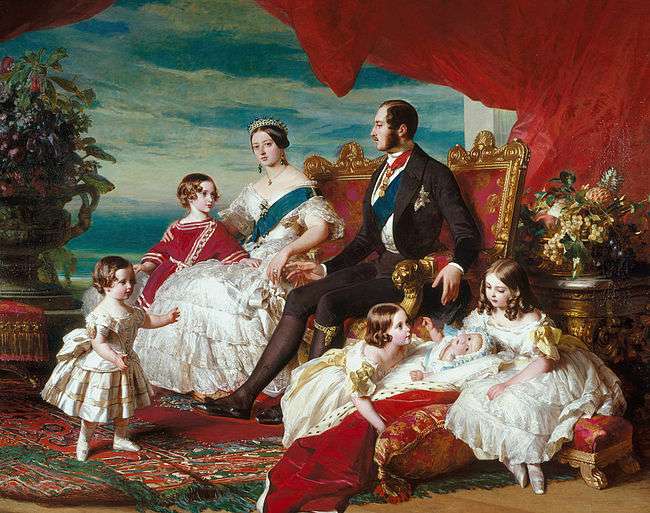 |
| Name | Birth | Death | Spouse (dates of birth & death) and children[2][9] | |
|---|---|---|---|---|
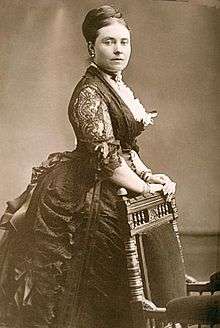 |
The Princess Victoria, Princess Royal | 21 November 1840 | 5 August 1901 | Married 1858 (January 25), Prussian Crown Prince Frederick (1831–1888), later Frederick III, German Emperor and King of Prussia 4 sons, 4 daughters (including German Emperor William II and Sophia, Queen of the Hellenes) |
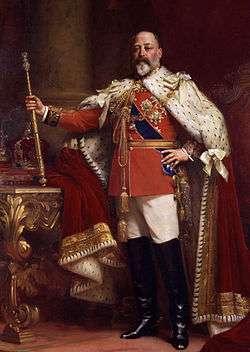 |
The Prince Albert Edward, Prince of Wales, later Edward VII | 9 November 1841 | 6 May 1910 | Married 1863 (March 10), Princess Alexandra of Denmark (1844–1925); 3 sons, 3 daughters (including King George V and Maud, Queen of Norway) |
 |
The Princess Alice | 25 April 1843 | 14 December 1878 | Married 1862 (July 1), Louis IV, Grand Duke of Hesse and by Rhine (1837–1892); 2 sons, 5 daughters (including Alexandra, the last Empress of All the Russias) |
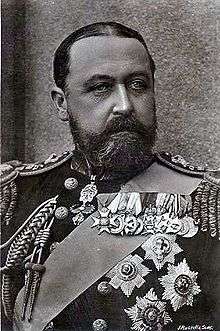 |
The Prince Alfred, Duke of Saxe-Coburg and Gotha and Duke of Edinburgh; Admiral of the Fleet | 6 August 1844 | 31 July 1900 | Married 1874 (January 23), Grand Duchess Maria Alexandrovna of Russia (1853–1920); 2 sons (1 still-born), 4 daughters (including Marie, Queen of Romania) |
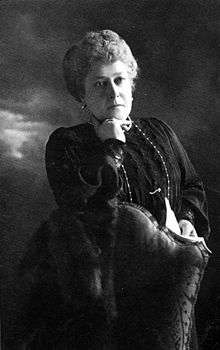 |
The Princess Helena | 25 May 1846 | 9 June 1923 | Married 1866 (July 5), Prince Christian of Schleswig-Holstein-Sonderburg-Augustenburg (1831–1917); 4 sons (1 still-born), 2 daughters |
 |
The Princess Louise | 18 March 1848 | 3 December 1939 | Married 1871 (March 21), John Douglas Sutherland Campbell (1845–1914), Marquess of Lorne, later 9th Duke of Argyll and Governor-General of Canada (1878–1883); no issue |
 |
The Prince Arthur, Duke of Connaught and Strathearn; Field Marshal, Governor General of Canada (1911–1916) | 1 May 1850 | 16 January 1942 | Married 1879 (March 13), Princess Louise Margaret of Prussia (1860–1917); 1 son, 2 daughters (including Margaret, Crown Princess of Sweden) |
 |
The Prince Leopold, Duke of Albany | 7 April 1853 | 28 March 1884 | Married 1882 (April 27), Princess Helena of Waldeck and Pyrmont (1861–1922); 1 son, 1 daughter |
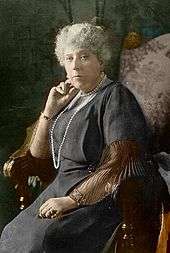 |
The Princess Beatrice | 14 April 1857 | 26 October 1944 | Married 1885 (July 23), Prince Henry of Battenberg (1858–1896); 3 sons, 1 daughter (including Victoria Eugenie, Queen of Spain) |
Children and grandchildren of Victoria and Albert
Victoria, the Princess Royal
The eldest child of Victoria and Albert, Princess Victoria (the Princess Royal), called "Vicky" was born on 21 November 1840 and died on 5 August 1901, seven months after her mother's death in January. On 25 January 1858 she married Prince Frederick of Prussia (1831–1888; Crown Prince from 1861, German Emperor March–June 1888). They had eight children and twenty-three grandchildren.
Not only was the Princess Royal the first child of Queen Victoria and Prince Albert, she also gave them their first grandchild (the future Emperor Wilhelm II, 27 January 1859 – 4 June 1941) and was grandmother to both the first of their 87 great-grandchildren to be born, Princess Feodora of Saxe-Meiningen (19 May 1879 – 26 August 1945), daughter of Princess Charlotte, and to the last of their 29 great-granddaughters to die, Lady Katherine Brandram (4 May 1913 – 2 October 2007), daughter of Princess Sophie.
Both the German Emperor Wilhelm II and the British King-Emperor George V (son of the Princess Royal's younger brother Edward VII) were grandchildren of Queen Victoria, as was Alexandra, daughter of Princess Alice and wife of the Russian Tsar Nicholas II.
Queen Victoria → Princess Victoria → German Emperor William II
Queen Victoria → King Edward VII → King George V
Queen Victoria → Princess Alice → Empress Alexandra
| The Marriage of Princess Victoria and Crown Prince Frederick of Prussia | ||||
| Name | Birth | Death | Notes[2] | |
|---|---|---|---|---|
 |
Princess Victoria, the Princess Royal | 21 November 1840 Buckingham Palace, Westminster (London) | 5 August 1901 Schloss Friedrichshof, Kronberg im Taunus, Grand Duchy of Hesse, (Germany) | Married 25 January 1858 in St James' Palace, Westminster (London). 4 sons, 4 daughters (including German Emperor William II and Sophia, Queen of the Greeks); 18 grandsons, 5 granddaughters (including Kings George II, Alexander I and Paul I of Greece and Queen Helen of Romania) ¶ Crown Prince Frederick succeeded his father Emperor Wilhelm I on 9 March 1888, but died in June. |
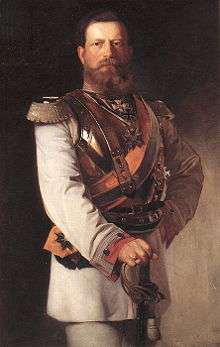 |
Crown Prince Frederick of Prussia, later Frederick III, German Emperor and King of Prussia |
18 October 1831 New Palace, Potsdam, Prussia, (Germany) |
15 June 1888 New Palace, Potsdam, Prussia, (Germany) | |
| Ancestors of Frederick III, King of Prussia and German Emperor | |||||||||||||||||||||||||||||||||||||||||||||||||||||||||||||||||||||||||||||||||||||||||||||||||||||||||||||||||||||||||||||||||||||||||||||||||||||||||||||||||||||||||||||||||||||||||||||||||||||||||||||||||||||||||||||||||||||||||||||||||||||||||||||||||||||||||||||||||||||||||||||||||||||||||||||||||||||||||||||||||||||||||||||||||||||||||||||||||||||||||||||||||||||||||||||||||||||||||||||||||||||||||||||||||||||||||||||||||||||||||||||||||||||||||||||||||||||||||||||||||||||||||||||||||||||||||||||||||||||||||||||||||||||||||||||||||||||||||||||||||||||||||||||||||||||||||||||||||||||||||||||||||||||||||||||||||||||||||||||||||||||||||||||||||||||||||||||||||||||||||||||||||||||||||||||||||||||||||||||||||||||||||||||||||||||||||||||||||||||||||||||||||||||||||||||||||||||||||||||||||||||||||||||||||||||||||||||||||||||||||||||||||||||||||||||||||||||||||||||||||||||||||||||||||||||||||||||||||||||||||||||||||||||||||||||||||||||||||||||||||||||||||||||||||||||||||||||||||||||||
|---|---|---|---|---|---|---|---|---|---|---|---|---|---|---|---|---|---|---|---|---|---|---|---|---|---|---|---|---|---|---|---|---|---|---|---|---|---|---|---|---|---|---|---|---|---|---|---|---|---|---|---|---|---|---|---|---|---|---|---|---|---|---|---|---|---|---|---|---|---|---|---|---|---|---|---|---|---|---|---|---|---|---|---|---|---|---|---|---|---|---|---|---|---|---|---|---|---|---|---|---|---|---|---|---|---|---|---|---|---|---|---|---|---|---|---|---|---|---|---|---|---|---|---|---|---|---|---|---|---|---|---|---|---|---|---|---|---|---|---|---|---|---|---|---|---|---|---|---|---|---|---|---|---|---|---|---|---|---|---|---|---|---|---|---|---|---|---|---|---|---|---|---|---|---|---|---|---|---|---|---|---|---|---|---|---|---|---|---|---|---|---|---|---|---|---|---|---|---|---|---|---|---|---|---|---|---|---|---|---|---|---|---|---|---|---|---|---|---|---|---|---|---|---|---|---|---|---|---|---|---|---|---|---|---|---|---|---|---|---|---|---|---|---|---|---|---|---|---|---|---|---|---|---|---|---|---|---|---|---|---|---|---|---|---|---|---|---|---|---|---|---|---|---|---|---|---|---|---|---|---|---|---|---|---|---|---|---|---|---|---|---|---|---|---|---|---|---|---|---|---|---|---|---|---|---|---|---|---|---|---|---|---|---|---|---|---|---|---|---|---|---|---|---|---|---|---|---|---|---|---|---|---|---|---|---|---|---|---|---|---|---|---|---|---|---|---|---|---|---|---|---|---|---|---|---|---|---|---|---|---|---|---|---|---|---|---|---|---|---|---|---|---|---|---|---|---|---|---|---|---|---|---|---|---|---|---|---|---|---|---|---|---|---|---|---|---|---|---|---|---|---|---|---|---|---|---|---|---|---|---|---|---|---|---|---|---|---|---|---|---|---|---|---|---|---|---|---|---|---|---|---|---|---|---|---|---|---|---|---|---|---|---|---|---|---|---|---|---|---|---|---|---|---|---|---|---|---|---|---|---|---|---|---|---|---|---|---|---|---|---|---|---|---|---|---|---|---|---|---|---|---|---|---|---|---|---|---|---|---|---|---|---|---|---|---|---|---|---|---|---|---|---|---|---|---|---|---|---|---|---|---|---|---|---|---|---|---|---|---|---|---|---|---|---|---|---|---|---|---|---|---|---|---|---|---|---|---|---|---|---|---|---|---|---|---|---|---|---|---|---|---|---|---|---|---|---|---|---|---|---|---|---|---|---|---|---|---|---|---|---|---|---|---|---|---|---|---|---|---|---|---|---|---|---|---|---|---|---|---|---|---|---|---|---|---|---|---|---|---|---|---|---|---|---|---|---|---|---|---|---|---|---|---|---|---|---|---|---|---|---|---|---|---|---|---|---|---|---|---|---|---|---|---|---|---|---|---|---|---|---|---|---|---|---|---|---|---|---|---|---|---|---|---|---|---|---|---|---|---|---|---|---|---|---|---|---|---|---|---|---|---|---|---|---|---|---|---|---|---|---|---|---|---|---|---|---|---|---|---|---|---|---|---|---|---|---|---|---|---|---|---|---|---|---|---|---|---|---|---|---|---|---|---|---|---|---|---|---|---|---|---|---|---|---|---|---|---|---|---|---|---|---|---|---|---|---|---|---|---|---|---|---|---|---|---|---|---|---|---|---|---|---|---|---|---|---|---|---|---|---|---|---|---|---|---|---|---|---|---|---|---|---|---|---|---|---|---|---|---|---|---|---|---|---|---|---|---|---|---|---|---|---|---|---|---|---|---|---|---|---|---|---|---|---|---|---|---|---|---|---|---|---|---|---|---|---|---|---|---|---|---|---|---|---|---|---|---|---|---|---|---|---|---|---|---|---|---|---|---|---|---|---|---|---|---|---|---|---|---|---|---|---|---|---|---|---|---|---|---|---|---|---|---|---|---|---|---|---|---|---|---|---|---|---|---|---|---|---|---|---|---|---|---|---|---|---|---|---|---|---|---|---|---|---|---|---|---|---|---|---|---|---|---|---|---|---|---|---|---|---|---|---|---|---|---|---|---|---|---|---|---|---|---|---|---|---|---|---|---|---|---|---|---|---|---|---|---|---|---|---|---|---|---|---|---|---|---|---|---|---|---|---|---|---|---|---|---|---|---|---|---|---|---|---|---|---|---|---|---|---|---|---|---|---|---|---|---|---|---|---|---|---|---|---|---|---|---|---|---|---|---|---|---|---|---|---|---|---|---|
|
<td rowspan="2" " style="border-left: 1px solid black;">
| |||||||||||||||||||||||||||||||||||||||||||||||||||||||||||||||||||||||||||||||||||||||||||||||||||||||||||||||||||||||||||||||||||||||||||||||||||||||||||||||||||||||||||||||||||||||||||||||||||||||||||||||||||||||||||||||||||||||||||||||||||||||||||||||||||||||||||||||||||||||||||||||||||||||||||||||||||||||||||||||||||||||||||||||||||||||||||||||||||||||||||||||||||||||||||||||||||||||||||||||||||||||||||||||||||||||||||||||||||||||||||||||||||||||||||||||||||||||||||||||||||||||||||||||||||||||||||||||||||||||||||||||||||||||||||||||||||||||||||||||||||||||||||||||||||||||||||||||||||||||||||||||||||||||||||||||||||||||||||||||||||||||||||||||||||||||||||||||||||||||||||||||||||||||||||||||||||||||||||||||||||||||||||||||||||||||||||||||||||||||||||||||||||||||||||||||||||||||||||||||||||||||||||||||||||||||||||||||||||||||||||||||||||||||||||||||||||||||||||||||||||||||||||||||||||||||||||||||||||||||||||||||||||||||||||||||||||||||||||||||||||||||||||||||||||||||||||||||||||||||
Children of the Princess Royal and Crown Prince Frederick of Prussia
The portrait below shows the Princess Royal with her husband Frederick and with Victoria and Albert's first two grandchildren, the future Kaiser Wilhelm II (1859–1941) and Princess Charlotte (1860–1919), who were the only grandchildren born during Albert's lifetime.
| Portrait of Crown Princess Victoria's family in 1862 by Franz Xaver Winterhalter |
|---|
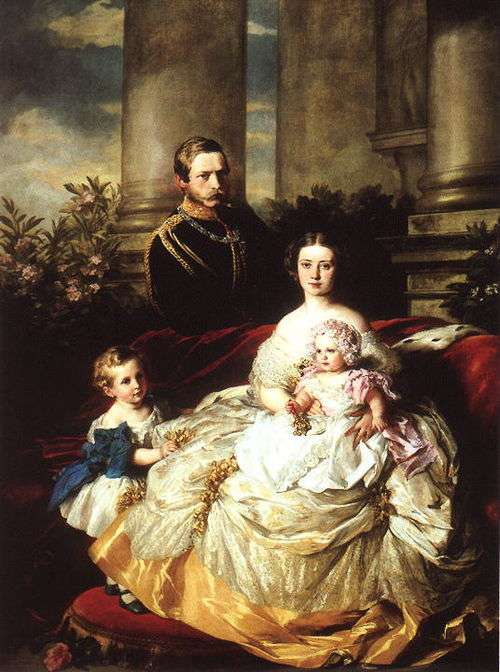 |
| Picture | Name | Birth | Death | Notes[3] |
|---|---|---|---|---|
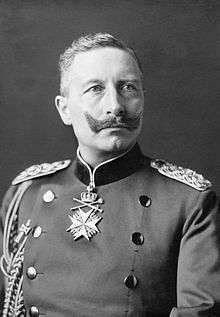 |
Crown Prince Wilhelm, later Wilhelm II, German Emperor and King of Prussia |
27 January 1859 Berlin, Prussia |
3 June 1941 Doorn, Netherlands |
Reigned from 15 June 1888 to 9 November 1918 (abdicated) |
| Married (1) 1881, Princess Augusta Victoria of Schleswig-Holstein-Sonderburg-Augustenburg (1858–1921) with issue (6 sons, 1 daughter): Crown Prince William (1882–1951), Prince Eitel Friedrich (1883–1942), Prince Adalbert (1884–1948), Prince August Wilhelm (1887–1949), Prince Oskar (1888–1958), Prince Joachim (1890–1920) and Princess Victoria Louise (1892–1980) | ||||
| Married (2) 1922 Princess Hermine Reuss of Greiz (1887–1947), no issue. | ||||
 | Princess Charlotte of Prussia | 24 July 1860 Potsdam, Prussia | 19 October 1919 Baden-Baden, German Republic | Married 1878 Bernhard of Saxe-Meiningen, (1851–1928), later Duke Bernhard III (1914–1918), with issue (1 daughter): Princess Feodora (19 May 1879 – 26 August 1945), — Queen Victoria's first great-grandchild. Modern medical tests revealed that both Charlotte and her daughter suffered from porphyria, which afflicted their ancestor George III.[10] |
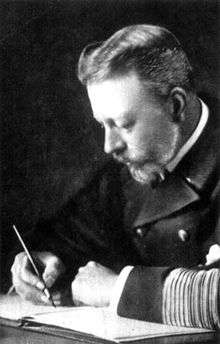 | Prince Henry of Prussia | 14 August 1862 Potsdam, Prussia | 20 April 1929 Hemmelmark, German Republic |
Married 1888 Princess Irene of Hesse and by Rhine (1866–1953), daughter of his aunt Princess Alice (see below) and had issue (3 sons): Prince Waldemar (1889–1945), Prince Sigismund (1896–1978) and Prince Heinrich (1900–1904). |
.jpg) | Prince Sigismund of Prussia | 15 September 1864 Potsdam, Prussia | 18 June 1866 Potsdam, Prussia | Died young from meningitis. |
_(April_12%2C_1866_%E2%80%93_November_13%2C_1929).jpg) |
Princess Viktoria of Prussia | 12 April 1866 Potsdam, Prussia |
13 November 1929 Bonn, German Republic |
Married (1) 1890 Prince Adolf of Schaumburg-Lippe (1859–1917), no issue |
| Married (2) 1927 Alexander Zoubkoff, no issue. | ||||
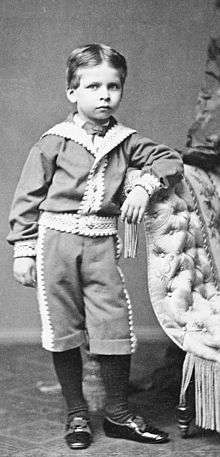 | Prince Waldemar of Prussia | 10 February 1868 Berlin, Prussia | 27 March 1879 Potsdam, Prussia | Died young from diphtheria. |
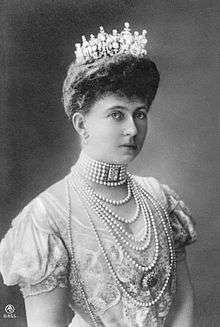 | Princess Sophie of Prussia, later Queen of the Hellenes [Greeks] | 14 June 1870 Berlin, Prussia | 13 January 1932 Frankfurt- am-Main, German Republic | Married 1889 King Constantine I of Greece (1868–1923) and had issue (3 sons, 3 daughters): Crown Prince George (1890–1947), later King George II, Prince Alexander (1893–1920), later King Alexander I and father of Princess Alexandra of Greece and Denmark, later Queen Alexandra of Yugoslavia Princess Helen (1896–1982), later Queen of Romania and mother of King Michael of Romania, Prince Paul (1901–1964), later King Paul I and father of King Constantine II of Greece and Queen Sofía of Spain Princess Irene (1904–1974), and Princess Katherine (Lady Katherine Brandram) (1913–2007). |
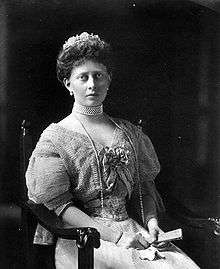 | Princess Margaret of Prussia | 22 April 1872 Potsdam, Prussia | 22 January 1954 Kronberg, West Germany |
Married 1893 Prince Frederick Charles of Hesse (1868–1940), later elected King of Finland (October–December 1918), and had issue (6 sons): Prince Friedrich Wilhelm (1893–1916), Prince Maximilian (1894–1914), Prince Philipp (1896–1980) and Prince Wolfgang (1896–1989) (twins), Prince Christoph (1901–1943) and Prince Richard (1901–1969) (twins). |
Edward VII
Prince Albert Edward (1841–1910), then the Prince of Wales, married Princess Princess Alexandra of Denmark (1844–1925), later Queen Alexandra of the United Kingdom, on 10 March 1863. They had 3 sons (one of whom died within a day), 3 daughters, 7 grandsons (one stillborn) and 3 granddaughters. The Prince of Wales became King Edward VII and Emperor of India at the death of his mother Queen Victoria on 22 January 1901.
Edward's and Alexandra's son King George V (reigned 1910–1936) was the father of Kings Edward VIII (reigned 1936) and George VI (1936–1952), and the grandfather of the present Queen Elizabeth II (acceded to the throne February 1952) and her sister Princess Margaret, Countess of Snowdon (1930–2002). As the only children of George VI and Elizabeth Bowes-Lyon (the Queen Mother, 1900–2002), Elizabeth and Margaret were thus great-granddaughters of Edward VII, great-great-granddaughters of Queen Victoria, and great-great-great-great-granddaughters of Victoria's grandfather, King George III.
George III → Edward, Duke of Kent → Queen Victoria → Edward VII → George V → George VI → Elizabeth II
Edward's and Alexandra's daughter Princess Maud of Wales became Queen of Norway when her husband, Prince Carl of Denmark, became King Haakon VII (1905–1957) upon the dissolution of Norway's union with Sweden in 1905. Their son, and Edward's grandson, became King Olav V (1957–1991); and Olav's children, King Harald V (since 1991), Princess Ragnhild and Princess Astrid, are thus great-grandchildren of Edward VII and great-great-grandchildren of Victoria and Albert.
Queen Victoria → King Edward VII → Princess Maud of Wales → King Olav V → King Harald V
| The Marriage of Edward, Prince of Wales, and Princess Alexandra of Denmark | ||||
| Name | Birth | Death | Marriage and children | |
|---|---|---|---|---|
 |
Prince Albert Edward, Prince of Wales, later King Edward VII and Emperor of India | 9 November 1841 Buckingham Palace, Westminster (London) | 6 May 1910 Buckingham Palace, Westminster (London) |
Married 10 March 1863 in St. George's Chapel, Windsor Castle. 3 sons, 3 daughters (including King George V and Maud, Queen of Norway); 7 grandsons, 3 granddaughters (including British Kings Edward VIII & George VI, and Norwegian King Olav V) ¶ Edward acceded to the throne when his mother Queen Victoria died on 22 January 1901. He and Princess Alexandra were crowned King and Queen on 2 August 1902 in Westminster Abbey (London) by Frederick Temple, the Archbishop of Canterbury |
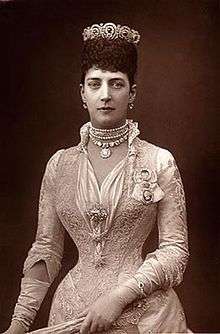 |
Princess Alexandra of Denmark later Queen Alexandra of the United Kingdom and Empress of India |
1 December 1844 Yellow Palace, near Amalienborg Palace, Copenhagen, Denmark |
20 November 1925 Sandringham House, Norfolk, England | |
| Ancestors of Queen Alexandra (Princess Alexandra of Denmark) | |||||||||||||||||||||||||||||||||||||||||||||||||||||||||||||||||||||||||||||||||||||||||||||||||||||||||||||||||||||||||||||||||||||||||||||||||||||||||||||||||||||||||||||||||||||||||||||||||||||||||||||||||||||||||||||||||||||||||||||||||||||||||||||||||||||||||||||||||||||||||||||||||||||||||||||||||||||||||||||||||||||||||||||||||||||||||||||||||||||||||||||||||||||||||||||||||||||||||||||||||||||||||||||||||||||||||||||||||||||||||||||||||||||||||||||||||||||||||||||||||||||||||||||||||||||||||||||||||||||||||||||||||||||||||||||||||||||||||||||||||||||||||||||||||||||||||||||||||||||||||||||||||||||||||||||||||||||||||||||||||||||||||||||||||||||||||||||||||||||||||||||||||||||||||||||||||||||||||||||||||||||||||||||||||||||||||||||||||||||||||||||||||||||||||||||||||||||||||||||||||||||||||||||||||||||||||||||||||||||||||||||||||||||||||||||||||||||||||||||||||||||||||||||||||||||||||||||||||||||||||||||||||||||||||||||||||||||||||||||||||||||||||||||||||||||||||||||||||||||||
|---|---|---|---|---|---|---|---|---|---|---|---|---|---|---|---|---|---|---|---|---|---|---|---|---|---|---|---|---|---|---|---|---|---|---|---|---|---|---|---|---|---|---|---|---|---|---|---|---|---|---|---|---|---|---|---|---|---|---|---|---|---|---|---|---|---|---|---|---|---|---|---|---|---|---|---|---|---|---|---|---|---|---|---|---|---|---|---|---|---|---|---|---|---|---|---|---|---|---|---|---|---|---|---|---|---|---|---|---|---|---|---|---|---|---|---|---|---|---|---|---|---|---|---|---|---|---|---|---|---|---|---|---|---|---|---|---|---|---|---|---|---|---|---|---|---|---|---|---|---|---|---|---|---|---|---|---|---|---|---|---|---|---|---|---|---|---|---|---|---|---|---|---|---|---|---|---|---|---|---|---|---|---|---|---|---|---|---|---|---|---|---|---|---|---|---|---|---|---|---|---|---|---|---|---|---|---|---|---|---|---|---|---|---|---|---|---|---|---|---|---|---|---|---|---|---|---|---|---|---|---|---|---|---|---|---|---|---|---|---|---|---|---|---|---|---|---|---|---|---|---|---|---|---|---|---|---|---|---|---|---|---|---|---|---|---|---|---|---|---|---|---|---|---|---|---|---|---|---|---|---|---|---|---|---|---|---|---|---|---|---|---|---|---|---|---|---|---|---|---|---|---|---|---|---|---|---|---|---|---|---|---|---|---|---|---|---|---|---|---|---|---|---|---|---|---|---|---|---|---|---|---|---|---|---|---|---|---|---|---|---|---|---|---|---|---|---|---|---|---|---|---|---|---|---|---|---|---|---|---|---|---|---|---|---|---|---|---|---|---|---|---|---|---|---|---|---|---|---|---|---|---|---|---|---|---|---|---|---|---|---|---|---|---|---|---|---|---|---|---|---|---|---|---|---|---|---|---|---|---|---|---|---|---|---|---|---|---|---|---|---|---|---|---|---|---|---|---|---|---|---|---|---|---|---|---|---|---|---|---|---|---|---|---|---|---|---|---|---|---|---|---|---|---|---|---|---|---|---|---|---|---|---|---|---|---|---|---|---|---|---|---|---|---|---|---|---|---|---|---|---|---|---|---|---|---|---|---|---|---|---|---|---|---|---|---|---|---|---|---|---|---|---|---|---|---|---|---|---|---|---|---|---|---|---|---|---|---|---|---|---|---|---|---|---|---|---|---|---|---|---|---|---|---|---|---|---|---|---|---|---|---|---|---|---|---|---|---|---|---|---|---|---|---|---|---|---|---|---|---|---|---|---|---|---|---|---|---|---|---|---|---|---|---|---|---|---|---|---|---|---|---|---|---|---|---|---|---|---|---|---|---|---|---|---|---|---|---|---|---|---|---|---|---|---|---|---|---|---|---|---|---|---|---|---|---|---|---|---|---|---|---|---|---|---|---|---|---|---|---|---|---|---|---|---|---|---|---|---|---|---|---|---|---|---|---|---|---|---|---|---|---|---|---|---|---|---|---|---|---|---|---|---|---|---|---|---|---|---|---|---|---|---|---|---|---|---|---|---|---|---|---|---|---|---|---|---|---|---|---|---|---|---|---|---|---|---|---|---|---|---|---|---|---|---|---|---|---|---|---|---|---|---|---|---|---|---|---|---|---|---|---|---|---|---|---|---|---|---|---|---|---|---|---|---|---|---|---|---|---|---|---|---|---|---|---|---|---|---|---|---|---|---|---|---|---|---|---|---|---|---|---|---|---|---|---|---|---|---|---|---|---|---|---|---|---|---|---|---|---|---|---|---|---|---|---|---|---|---|---|---|---|---|---|---|---|---|---|---|---|---|---|---|---|---|---|---|---|---|---|---|---|---|---|---|---|---|---|---|---|---|---|---|---|---|---|---|---|---|---|---|---|---|---|---|---|---|---|---|---|---|---|---|---|---|---|---|---|---|---|---|---|---|---|---|---|---|---|---|---|---|---|---|---|---|---|---|---|---|---|---|---|---|---|---|---|---|---|---|---|---|---|---|---|---|---|---|---|---|---|---|---|---|---|---|---|---|---|---|---|---|---|---|---|---|---|---|---|---|---|---|---|---|---|---|---|---|---|---|---|---|---|---|---|---|---|---|---|---|---|---|---|---|---|---|---|---|---|---|---|---|---|---|---|---|---|---|---|---|---|---|---|---|---|---|---|---|---|---|---|---|---|---|---|---|---|---|---|---|---|---|---|---|---|---|---|---|---|---|---|---|---|---|---|---|---|---|---|---|---|---|---|---|---|---|---|---|---|---|---|
|
<td rowspan="2" " style="border-left: 1px solid black;">
| |||||||||||||||||||||||||||||||||||||||||||||||||||||||||||||||||||||||||||||||||||||||||||||||||||||||||||||||||||||||||||||||||||||||||||||||||||||||||||||||||||||||||||||||||||||||||||||||||||||||||||||||||||||||||||||||||||||||||||||||||||||||||||||||||||||||||||||||||||||||||||||||||||||||||||||||||||||||||||||||||||||||||||||||||||||||||||||||||||||||||||||||||||||||||||||||||||||||||||||||||||||||||||||||||||||||||||||||||||||||||||||||||||||||||||||||||||||||||||||||||||||||||||||||||||||||||||||||||||||||||||||||||||||||||||||||||||||||||||||||||||||||||||||||||||||||||||||||||||||||||||||||||||||||||||||||||||||||||||||||||||||||||||||||||||||||||||||||||||||||||||||||||||||||||||||||||||||||||||||||||||||||||||||||||||||||||||||||||||||||||||||||||||||||||||||||||||||||||||||||||||||||||||||||||||||||||||||||||||||||||||||||||||||||||||||||||||||||||||||||||||||||||||||||||||||||||||||||||||||||||||||||||||||||||||||||||||||||||||||||||||||||||||||||||||||||||||||||||||||||
Children of King Edward VII and Queen Alexandra
| Name | Birth | Death | Notes[3] | |
|---|---|---|---|---|
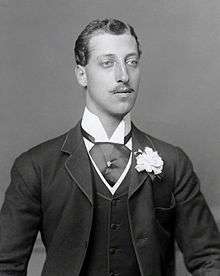 | Prince Albert Victor, Duke of Clarence | 8 January 1864 Frogmore House, Windsor, Berkshire | 14 January 1892 Sandringham House, Norfolk | Created Duke of Clarence and Avondale in 1890; died of influenza just after his 28th birthday. Engaged in 1891 to his cousin Princess Mary of Teck. |
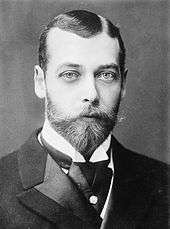 | Prince George, Prince of Wales, later King George V | 3 June 1865 Marlborough House, London | 20 January 1936 Sandringham House, Norfolk | Reigned from 6 May 1910 to 20 January 1936; married his cousin 1893 (July 6) Princess Mary of Teck, (26 May 1867 – 24 March 1953), later Queen Mary, and had issue (5 sons, 1 daughter): Edward, Prince of Wales (23 June 1894 – 28 May 1972) — later King Edward VIII (20 January – 11 December 1936), — later Prince Edward, Duke of Windsor (8 March 1937), Prince Albert, Duke of York (14 Dec. 1895 – 6 Feb. 1952) — later King George VI (11 Dec. 1936) and father of Queen Elizabeth II (born 21 April 1926, acceded 6 Feb. 1952, crowned 2 June 1953), Mary, Princess Royal (25 April 1897 – 28 March 1965), — later Countess of Harewood Prince Henry, Duke of Gloucester (31 March 1900 – 10 June 1974), Field Marshal, Marshal of the RAF, & Governor-General of Australia Prince George, Duke of Kent (20 Dec. 1902 – 25 August 1942, killed on active duty) and Prince John (12 July 1905 – 19 January 1919). |
 | Princess Louise, The Princess Royal | 20 February 1867 Marlborough House, London | 4 January 1931 Portman Square, London | Married 1889 Alexander Duff, 1st Duke of Fife (1849–1912) and had issue (1 son, 2 daughters): Alastair Duff, Earl of Macduff (stillborn, 1890), Princess Alexandra, 2nd Duchess of Fife (1891–1959) and Princess Maud, Countess of Southesk (1893–1945). |
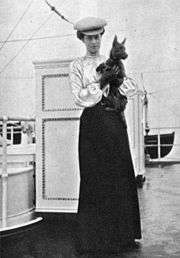 | Princess Victoria | 6 July 1868 Marlborough House, London | 3 December 1935 Coppins, Buckinghamshire | Died unmarried. |
 | Princess Maud of Wales later Queen of Norway | 26 November 1869 Marlborough House, London | 20 November 1938 London | Married 1896 Prince Carl of Denmark (1872–1957), — later King Haakon VII of Norway (1905–1957) and had issue (1 son): Prince Alexander (1903–1991), — later Crown Prince and King Olav V of Norway (1957–1991). |
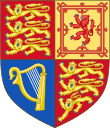 | Prince Alexander John of Wales | 6 April 1871 Sandringham House, Norfolk | 7 April 1871 Sandringham House, Norfolk | Born prematurely at 2:45 p.m., and died twenty-four hours later. He was christened privately by Reverend W. Lake Onslow in the evening after his birth. The christening was attended by the Prince and Princess of Wales, a lady-in-waiting and a doctor who had been at the birth.[11] |
Princess Alice
Princess Alice of the United Kingdom (1843–1878) married Prince Ludwig of Hesse (1837–1892), later Grand Duke Louis IV of Hesse, on 1 July 1862. They had 2 sons (one of which, "Frittie", Prince Friedrich of Hesse, was a haemophiliac and died from bleeding out after a fall out of his mother's bedroom window), 5 daughters (one of whom died of diphtheria) and 15 grandchildren (two of whom died at a young age). Prince Ludwig succeeded to the Grand Duchy of Hesse as Grand Duke Louis IV of Hesse, and Princess Alice as the Grand Duchess of Hesse, on 13 July 1877.
Alice and Louis's daughter, Princess Victoria of Hesse and by Rhine, married Prince Louis of Battenberg, and was the mother of Princess Alice of Battenberg (1885–1969), who became Alice, Princess Andrew of Greece and Denmark when she married Prince Andrew of Greece and Denmark on 6 October 1903. Princess Alice was the mother of Prince Philip, Duke of Edinburgh the current prince consort of the United Kingdom as the husband of Queen Elizabeth II. Princess Victoria was also the mother of Queen Louise of Sweden.
Queen Victoria → Princess Alice → Princess Victoria of Hesse → Princess Alice of Greece and Denmark → Prince Philip, Duke of Edinburgh.
Alice and Louis's second daughter, Princess Elisabeth of Hesse and by Rhine, married, in 1884, the Russian Grand Duke Sergei Alexandrovich, the fifth son of Tsar Alexander II and Empress Maria Alexandrovna, and younger brother of the then reigning Tsar Alexander III. They had no children. Following Sergei's assassination in 1905, she eventually became a nun and was killed by the Bolsheviks on July 18, 1918. She was canonized by the Russian Orthodox Church Outside of Russia in 1981 and in 1992 by the Moscow Patriarchate.
Prince Ernest Louis became Ernest Louis, Grand Duke of Hesse upon his father's death in 1892. He married his first cousin, Princess Victoria Melita of Saxe-Coburg and Gotha in 1894 and had one daughter, Princess Elisabeth of Hesse who died of typhoid fever, aged eight. The couple were divorced 21 December 1901. The Grand Duke married for a second time to Princess Eleonore of Solms-Hohensolms-Lich (1871–1947), and had two sons: Georg Donatus, Hereditary Grand Duke of Hesse who married Princess Cecilie of Greece, a sister of Prince Philip, Duke of Edinburgh and had issue, and Prince Louis of Hesse and by Rhine.
Princess Alix of Hesse, the youngest surviving child of the Grand Ducal pair, became the Last Empress of All the Russias through her marriage to Nicholas II of Russia in 1894. They had 5 children, 4 girls, the Grand Duchesses Olga, Tatiana, Maria and Anastasia, and one boy, the Tsarevich Alexei, who was a haemophiliac. The Russian Imperial Family was executed on 17 July 1918 by a detachment of Bolsheviks in the basement of Ipatiev House. The entire family was canonized by the Russian Orthodox church in 2000.
Queen Victoria → Princess Alice → Princess Alix, Tsarina Alexandra Feodorovna of Russia
| The Marriage of Princess Alice and Louis IV of Hesse | ||||
| Name | Birth | Death | Marriage and children | |
|---|---|---|---|---|
 |
Princess Alice of the United Kingdom | 25 April 1843 Buckingham Palace, London, England | 14 December 1878 New Palace, Darmstadt, Hesse (Germany) |
Married privately on 1 July 1862 (six months after the death of Alice's father Prince Albert), in the dining room of Osborne House, East Cowes (Isle of Wight), England 2 sons, 5 daughters (including Alexandra, the last Empress of Russia); 9 grandsons (1 stillborn), 7 granddaughters (including Queen Louise of Sweden and Earl Mountbatten of Burma, the last Viceroy of India) ¶ Prince Louis became Grand Duke of Hesse on 13 June 1877, less than two years before Princess Alice's death. |
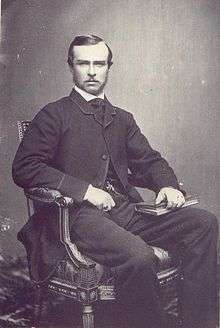 |
Prince Louis of Hesse, later Louis IV, Grand Duke of Hesse and by Rhine |
12 September 1837 Darmstadt, Hesse |
13 March 1892 | |
| Ancestors of Louis IV, Grand Duke of Hesse | |||||||||||||||||||||||||||||||||||||||||||||||||||||||||||||||||||||||||||||||||||||||||||||||||||||||||||||||||||||||||||||||||||||||||||||||||||||||||||||||||||||||||||||||||||||||||||||||||||||||||||||||||||||||||||||||||||||||||||||||||||||||||||||||||||||||||||||||||||||||||||||||||||||||||||||||||||||||||||||||||||||||||||||||||||||||||||||||||||||||||||||||||||||||||||||||||||||||||||||||||||||||||||||||||||||||||||||||||||||||||||||||||||||||||||||||||||||||||||||||||||||||||||||||||||||||||||||||||||||||||||||||||||||||||||||||||||||||||||||||||||||||||||||||||||||||||||||||||||||||||||||||||||||||||||||||||||||||||||||||||||||||||||||||||||||||||||||||||||||||||||||||||||||||||||||||||||||||||||||||||||||||||||||||||||||||||||||||||||||||||||||||||||||||||||||||||||||||||||||||||||||||||||||||||||||||||||||||||||||||||||||||||||||||||||||||||||||||||||||||||||||||||||||||||||||||||||||||||||||||||||||||||||||||||||||||||||||||||||||||||||||||||||||||||||||||||||||||||||||||
|---|---|---|---|---|---|---|---|---|---|---|---|---|---|---|---|---|---|---|---|---|---|---|---|---|---|---|---|---|---|---|---|---|---|---|---|---|---|---|---|---|---|---|---|---|---|---|---|---|---|---|---|---|---|---|---|---|---|---|---|---|---|---|---|---|---|---|---|---|---|---|---|---|---|---|---|---|---|---|---|---|---|---|---|---|---|---|---|---|---|---|---|---|---|---|---|---|---|---|---|---|---|---|---|---|---|---|---|---|---|---|---|---|---|---|---|---|---|---|---|---|---|---|---|---|---|---|---|---|---|---|---|---|---|---|---|---|---|---|---|---|---|---|---|---|---|---|---|---|---|---|---|---|---|---|---|---|---|---|---|---|---|---|---|---|---|---|---|---|---|---|---|---|---|---|---|---|---|---|---|---|---|---|---|---|---|---|---|---|---|---|---|---|---|---|---|---|---|---|---|---|---|---|---|---|---|---|---|---|---|---|---|---|---|---|---|---|---|---|---|---|---|---|---|---|---|---|---|---|---|---|---|---|---|---|---|---|---|---|---|---|---|---|---|---|---|---|---|---|---|---|---|---|---|---|---|---|---|---|---|---|---|---|---|---|---|---|---|---|---|---|---|---|---|---|---|---|---|---|---|---|---|---|---|---|---|---|---|---|---|---|---|---|---|---|---|---|---|---|---|---|---|---|---|---|---|---|---|---|---|---|---|---|---|---|---|---|---|---|---|---|---|---|---|---|---|---|---|---|---|---|---|---|---|---|---|---|---|---|---|---|---|---|---|---|---|---|---|---|---|---|---|---|---|---|---|---|---|---|---|---|---|---|---|---|---|---|---|---|---|---|---|---|---|---|---|---|---|---|---|---|---|---|---|---|---|---|---|---|---|---|---|---|---|---|---|---|---|---|---|---|---|---|---|---|---|---|---|---|---|---|---|---|---|---|---|---|---|---|---|---|---|---|---|---|---|---|---|---|---|---|---|---|---|---|---|---|---|---|---|---|---|---|---|---|---|---|---|---|---|---|---|---|---|---|---|---|---|---|---|---|---|---|---|---|---|---|---|---|---|---|---|---|---|---|---|---|---|---|---|---|---|---|---|---|---|---|---|---|---|---|---|---|---|---|---|---|---|---|---|---|---|---|---|---|---|---|---|---|---|---|---|---|---|---|---|---|---|---|---|---|---|---|---|---|---|---|---|---|---|---|---|---|---|---|---|---|---|---|---|---|---|---|---|---|---|---|---|---|---|---|---|---|---|---|---|---|---|---|---|---|---|---|---|---|---|---|---|---|---|---|---|---|---|---|---|---|---|---|---|---|---|---|---|---|---|---|---|---|---|---|---|---|---|---|---|---|---|---|---|---|---|---|---|---|---|---|---|---|---|---|---|---|---|---|---|---|---|---|---|---|---|---|---|---|---|---|---|---|---|---|---|---|---|---|---|---|---|---|---|---|---|---|---|---|---|---|---|---|---|---|---|---|---|---|---|---|---|---|---|---|---|---|---|---|---|---|---|---|---|---|---|---|---|---|---|---|---|---|---|---|---|---|---|---|---|---|---|---|---|---|---|---|---|---|---|---|---|---|---|---|---|---|---|---|---|---|---|---|---|---|---|---|---|---|---|---|---|---|---|---|---|---|---|---|---|---|---|---|---|---|---|---|---|---|---|---|---|---|---|---|---|---|---|---|---|---|---|---|---|---|---|---|---|---|---|---|---|---|---|---|---|---|---|---|---|---|---|---|---|---|---|---|---|---|---|---|---|---|---|---|---|---|---|---|---|---|---|---|---|---|---|---|---|---|---|---|---|---|---|---|---|---|---|---|---|---|---|---|---|---|---|---|---|---|---|---|---|---|---|---|---|---|---|---|---|---|---|---|---|---|---|---|---|---|---|---|---|---|---|---|---|---|---|---|---|---|---|---|---|---|---|---|---|---|---|---|---|---|---|---|---|---|---|---|---|---|---|---|---|---|---|---|---|---|---|---|---|---|---|---|---|---|---|---|---|---|---|---|---|---|---|---|---|---|---|---|---|---|---|---|---|---|---|---|---|---|---|---|---|---|---|---|---|---|---|---|---|---|---|---|---|---|---|---|---|---|---|---|---|---|---|---|---|---|---|---|---|---|---|---|---|---|---|---|---|---|---|---|---|---|---|---|---|---|---|---|---|---|---|---|---|---|---|---|---|---|---|---|---|---|---|---|---|---|---|---|---|---|---|---|---|---|---|---|---|---|---|---|---|---|---|---|---|---|---|---|---|---|---|
|
<td rowspan="2" " style="border-left: 1px solid black;">
| |||||||||||||||||||||||||||||||||||||||||||||||||||||||||||||||||||||||||||||||||||||||||||||||||||||||||||||||||||||||||||||||||||||||||||||||||||||||||||||||||||||||||||||||||||||||||||||||||||||||||||||||||||||||||||||||||||||||||||||||||||||||||||||||||||||||||||||||||||||||||||||||||||||||||||||||||||||||||||||||||||||||||||||||||||||||||||||||||||||||||||||||||||||||||||||||||||||||||||||||||||||||||||||||||||||||||||||||||||||||||||||||||||||||||||||||||||||||||||||||||||||||||||||||||||||||||||||||||||||||||||||||||||||||||||||||||||||||||||||||||||||||||||||||||||||||||||||||||||||||||||||||||||||||||||||||||||||||||||||||||||||||||||||||||||||||||||||||||||||||||||||||||||||||||||||||||||||||||||||||||||||||||||||||||||||||||||||||||||||||||||||||||||||||||||||||||||||||||||||||||||||||||||||||||||||||||||||||||||||||||||||||||||||||||||||||||||||||||||||||||||||||||||||||||||||||||||||||||||||||||||||||||||||||||||||||||||||||||||||||||||||||||||||||||||||||||||||||||||||||
Children of Princess Alice and Louis IV of Hesse
| Photograph of Princess Alice's family in 1876 |
|---|
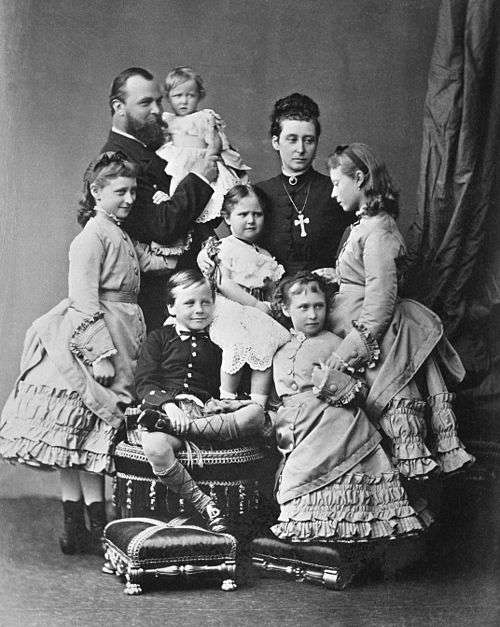 |
| Picture | Name | Birth | Death | Notes[3] |
|---|---|---|---|---|
 | Princess Victoria of Hesse and by Rhine | 5 April 1863 Windsor Castle, Berkshire, England | 24 September 1950 Kensington Palace, London, England | Married 1884 Prince Louis of Battenberg (1854–1921), Admiral of the Fleet, First Sea Lord [later Louis Mountbatten, 1st Marquess of Milford Haven, after renouncing German style and titles in July 1917], and had issue (2 sons, 2 daughters): Princess Alice (1885–1969), later Princess Andrew of Greece & Denmark, and mother of Prince Philip, Duke of Edinburgh Princess Louise (1889–1965), later Louise Mountbatten, Queen of Sweden and stepmother of Queen Ingrid of Denmark Prince George (1892–1938), later George Mountbatten, 2nd Marquess of Milford Haven and Prince Louis (1900–1979), later Earl Mountbatten of Burma, Admiral of the Fleet, last Viceroy of India & First Sea Lord |
 | Princess Elisabeth of Hesse and by Rhine | 1 November 1864 Bessungen, Hesse, Germany | 18 July 1918 Alapaevsk, Russia | Married 1885 Grand Duke Sergei Alexandrovich of Russia (1857–1905), no issue. |
 | Princess Irene of Hesse and by Rhine | 11 July 1866 Darmstadt, Hesse, Germany | 11 November 1953 Hemmelmark, Germany |
Married 1888 Prince Henry (1862–1929), son of her aunt Victoria, the British Princess Royal & German Empress (see above), and had issue (3 sons): Prince Waldemar of Prussia (1889–1945), Prince Sigismund of Prussia (1896–1978) and Prince Heinrich of Prussia. |
 |
Ernst Ludwig, later Grand Duke of Hesse |
25 November 1868 Darmstadt, Hesse, Germany |
9 October 1937 Langen, Germany |
Succeeded as head of the House of Hesse-Darmstadt in 1892. |
| Married (1) 1894 Princess Victoria Melita (1876–1936), daughter of his uncle Prince Alfred of Edinburgh (see below), and had issue (1 son, 1 daughter): Princess Elisabeth (1895–1903) and an unnamed stillborn son (1901); ¶ the marriage ended in divorce in 1901. | ||||
| Married (2) 1905 Princess Eleonore of Solms-Hohensolms-Lich (1871–1937) and had issue (2 sons): Hereditary Grand Duke Georg Donatus (1906–1937) and Prince Ludwig (1908–1968). | ||||
 | Prince Friedrich of Hesse and by Rhine | 7 October 1870 Darmstadt, Hesse, Germany | 29 May 1873 Darmstadt, Hesse, Germany | Suffered from haemophilia and died from a brain haemorrhage after falling from a window. |
 | Princess Alix of Hesse and by Rhine, later Empress Alexandra of All the Russias | 6 June 1872 Darmstadt, Hesse, Germany | 17 July 1918 Ekaterinburg, Russia | Married 1894 Tsar Nicholas II of Russia (1868–1918), taking the name Alexandra Feodorovna, and had issue (1 son, 4 daughters): Grand Duchess Olga (1895–1918), Grand Duchess Tatiana (1897–1918), Grand Duchess Maria (1899–1918), Grand Duchess Anastasia (1901–1918), Tsarevich Alexei (1904–1918). ¶ The entire family was killed in July 1918 in the aftermath of the Bolshevik Revolution, as was Alexandra's sister, the Grand Duchess Elisabeth (Princess Elisabeth of Hesse, see above). |
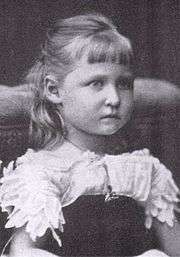 | Princess Marie of Hesse and by Rhine | 24 May 1874 Darmstadt, Hesse, Germany | 16 November 1878 Darmstadt, Hesse, Germany | Died young from diphtheria. |
Prince Alfred, Duke of Edinburgh
Prince Alfred (1844–1900) married the Grand Duchess Maria Alexandrovna of Russia (1853–1920), the only surviving daughter of Tsar Alexander II and his first wife, Empress Marie Alexandrovna, on 23 January 1874 at the Winter Palace in St Petersburg, Russia. They had 2 sons (one stillborn), 4 daughters, 10 grandsons (8 of whom survived their first week of life) and 9 granddaughters. In June 1893, Prince Alfred achieved the Royal Navy rank of Admiral of the Fleet, shortly before succeeding his uncle, Ernest II, as Duke of Saxe-Coburg and Gotha in August 1893.
Prince Alfred's daughter (and Queen Victoria's granddaughter) Princess Marie of Edinburgh became Queen of Romania in 1914 after marrying the future King Ferdinand in 1893.
- King Ferdinand's and Queen Marie's son King Carol II of Romania (Victoria's great-grandson) was father to King Michael of Romania (a great-great-grandson of Victoria);
- their daughter (and Victoria's great-granddaughter) Princess Elisabeth was married from 1922 to 1935 to King George II of Greece (reigned 1923–1924 & 1935–1947); and
- their daughter (and Victoria's great-granddaughter) Princess Maria was married to King Alexander I of Yugoslavia (reigned 1921–1934) and the mother of King Peter II (reigned 1934–1945, another great-great-grandson of Queen Victoria)
Queen Victoria → Prince Alfred → Queen Marie of Romania → King Carol II → King Michael
Queen Victoria → Prince Alfred → Queen Marie of Romania → Queen Elisabeth of the Hellenes
Queen Victoria → Prince Alfred → Queen Marie of Romania → Queen Marie of Yugoslavia → King Peter II
| The Marriage of Alfred, Duke of Edinburgh, and Grand Duchess Maria Alexandrovna of Russia | ||||
| Name | Birth | Death | Marriage and children | |
|---|---|---|---|---|
 |
Prince Alfred, later Duke of Saxe-Coburg and Gotha and Duke of Edinburgh; Admiral of the Fleet | 6 August 1844 Windsor Castle, Berkshire, England | 31 July 1900 Rosenau Castle, Coburg, Germany |
Married 23 January 1874 at the Winter Palace, St Petersburg, Russia; 2 sons (1 still-born), 4 daughters (including Marie, Queen of Romania) 10 grandsons (of whom 1 stillborn), 9 granddaughters (including King Carol II of Romania, Queen Elisabeth of Greece and Queen Maria of Yugoslavia) ¶ Prince Alfred was made Duke of Edinburgh on 24 May 1866, and succeeded as Duke of Saxe-Coburg and Gotha on 22 August 1893, living there until his death in 1900. |
 |
Grand Duchess Maria Alexandrovna of Russia, daughter of Tsar Alexander II |
17 October 1853 Tsarskoye Selo, Russia |
24 October 1920 Zürich, Switzerland | |
| Ancestors of Grand Duchess Maria Alexandrovna of Russia | |||||||||||||||||||||||||||||||||||||||||||||||||||||||||||||||||||||||||||||||||||||||||||||||||||||||||||||||||||||||||||||||||||||||||||||||||||||||||||||||||||||||||||||||||||||||||||||||||||||||||||||||||||||||||||||||||||||||||||||||||||||||||||||||||||||||||||||||||||||||||||||||||||||||||||||||||||||||||||||||||||||||||||||||||||||||||||||||||||||||||||||||||||||||||||||||||||||||||||||||||||||||||||||||||||||||||||||||||||||||||||||||||||||||||||||||||||||||||||||||||||||||||||||||||||||||||||||||||||||||||||||||||||||||||||||||||||||||||||||||||||||||||||||||||||||||||||||||||||||||||||||||||||||||||||||||||||||||||||||||||||||||||||||||||||||||||||||||||||||||||||||||||||||||||||||||||||||||||||||||||||||||||||||||||||||||||||||||||||||||||||||||||||||||||||||||||||||||||||||||||||||||||||||||||||||||||||||||||||||||||||||||||||||||||||||||||||||||||||||||||||||||||||||||||||||||||||||||||||||||||||||||||||||||||||||||||||||||||||||||||||||||||||||||||||||||||||||||||||||||
|---|---|---|---|---|---|---|---|---|---|---|---|---|---|---|---|---|---|---|---|---|---|---|---|---|---|---|---|---|---|---|---|---|---|---|---|---|---|---|---|---|---|---|---|---|---|---|---|---|---|---|---|---|---|---|---|---|---|---|---|---|---|---|---|---|---|---|---|---|---|---|---|---|---|---|---|---|---|---|---|---|---|---|---|---|---|---|---|---|---|---|---|---|---|---|---|---|---|---|---|---|---|---|---|---|---|---|---|---|---|---|---|---|---|---|---|---|---|---|---|---|---|---|---|---|---|---|---|---|---|---|---|---|---|---|---|---|---|---|---|---|---|---|---|---|---|---|---|---|---|---|---|---|---|---|---|---|---|---|---|---|---|---|---|---|---|---|---|---|---|---|---|---|---|---|---|---|---|---|---|---|---|---|---|---|---|---|---|---|---|---|---|---|---|---|---|---|---|---|---|---|---|---|---|---|---|---|---|---|---|---|---|---|---|---|---|---|---|---|---|---|---|---|---|---|---|---|---|---|---|---|---|---|---|---|---|---|---|---|---|---|---|---|---|---|---|---|---|---|---|---|---|---|---|---|---|---|---|---|---|---|---|---|---|---|---|---|---|---|---|---|---|---|---|---|---|---|---|---|---|---|---|---|---|---|---|---|---|---|---|---|---|---|---|---|---|---|---|---|---|---|---|---|---|---|---|---|---|---|---|---|---|---|---|---|---|---|---|---|---|---|---|---|---|---|---|---|---|---|---|---|---|---|---|---|---|---|---|---|---|---|---|---|---|---|---|---|---|---|---|---|---|---|---|---|---|---|---|---|---|---|---|---|---|---|---|---|---|---|---|---|---|---|---|---|---|---|---|---|---|---|---|---|---|---|---|---|---|---|---|---|---|---|---|---|---|---|---|---|---|---|---|---|---|---|---|---|---|---|---|---|---|---|---|---|---|---|---|---|---|---|---|---|---|---|---|---|---|---|---|---|---|---|---|---|---|---|---|---|---|---|---|---|---|---|---|---|---|---|---|---|---|---|---|---|---|---|---|---|---|---|---|---|---|---|---|---|---|---|---|---|---|---|---|---|---|---|---|---|---|---|---|---|---|---|---|---|---|---|---|---|---|---|---|---|---|---|---|---|---|---|---|---|---|---|---|---|---|---|---|---|---|---|---|---|---|---|---|---|---|---|---|---|---|---|---|---|---|---|---|---|---|---|---|---|---|---|---|---|---|---|---|---|---|---|---|---|---|---|---|---|---|---|---|---|---|---|---|---|---|---|---|---|---|---|---|---|---|---|---|---|---|---|---|---|---|---|---|---|---|---|---|---|---|---|---|---|---|---|---|---|---|---|---|---|---|---|---|---|---|---|---|---|---|---|---|---|---|---|---|---|---|---|---|---|---|---|---|---|---|---|---|---|---|---|---|---|---|---|---|---|---|---|---|---|---|---|---|---|---|---|---|---|---|---|---|---|---|---|---|---|---|---|---|---|---|---|---|---|---|---|---|---|---|---|---|---|---|---|---|---|---|---|---|---|---|---|---|---|---|---|---|---|---|---|---|---|---|---|---|---|---|---|---|---|---|---|---|---|---|---|---|---|---|---|---|---|---|---|---|---|---|---|---|---|---|---|---|---|---|---|---|---|---|---|---|---|---|---|---|---|---|---|---|---|---|---|---|---|---|---|---|---|---|---|---|---|---|---|---|---|---|---|---|---|---|---|---|---|---|---|---|---|---|---|---|---|---|---|---|---|---|---|---|---|---|---|---|---|---|---|---|---|---|---|---|---|---|---|---|---|---|---|---|---|---|---|---|---|---|---|---|---|---|---|---|---|---|---|---|---|---|---|---|---|---|---|---|---|---|---|---|---|---|---|---|---|---|---|---|---|---|---|---|---|---|---|---|---|---|---|---|---|---|---|---|---|---|---|---|---|---|---|---|---|---|---|---|---|---|---|---|---|---|---|---|---|---|---|---|---|---|---|---|---|---|---|---|---|---|---|---|---|---|---|---|---|---|---|---|---|---|---|---|---|---|---|---|---|---|---|---|---|---|---|---|---|---|---|---|---|---|---|---|---|---|---|---|---|---|---|---|---|---|---|---|---|---|---|---|---|---|---|---|---|---|---|---|---|---|---|---|---|---|---|---|---|---|---|---|---|---|---|---|---|---|---|---|---|---|---|---|---|---|---|---|---|---|---|---|---|---|---|---|---|---|---|---|---|---|---|---|---|---|---|---|---|---|---|---|---|---|---|---|---|---|---|---|---|---|
|
<td rowspan="2" " style="border-left: 1px solid black;">
| |||||||||||||||||||||||||||||||||||||||||||||||||||||||||||||||||||||||||||||||||||||||||||||||||||||||||||||||||||||||||||||||||||||||||||||||||||||||||||||||||||||||||||||||||||||||||||||||||||||||||||||||||||||||||||||||||||||||||||||||||||||||||||||||||||||||||||||||||||||||||||||||||||||||||||||||||||||||||||||||||||||||||||||||||||||||||||||||||||||||||||||||||||||||||||||||||||||||||||||||||||||||||||||||||||||||||||||||||||||||||||||||||||||||||||||||||||||||||||||||||||||||||||||||||||||||||||||||||||||||||||||||||||||||||||||||||||||||||||||||||||||||||||||||||||||||||||||||||||||||||||||||||||||||||||||||||||||||||||||||||||||||||||||||||||||||||||||||||||||||||||||||||||||||||||||||||||||||||||||||||||||||||||||||||||||||||||||||||||||||||||||||||||||||||||||||||||||||||||||||||||||||||||||||||||||||||||||||||||||||||||||||||||||||||||||||||||||||||||||||||||||||||||||||||||||||||||||||||||||||||||||||||||||||||||||||||||||||||||||||||||||||||||||||||||||||||||||||||||||||
Children of Alfred, Duke of Edinburgh, and Grand Duchess Marie
| Photograph of the Ducal Family of Saxe-Coburg and Gotha at Rosenau |
|---|
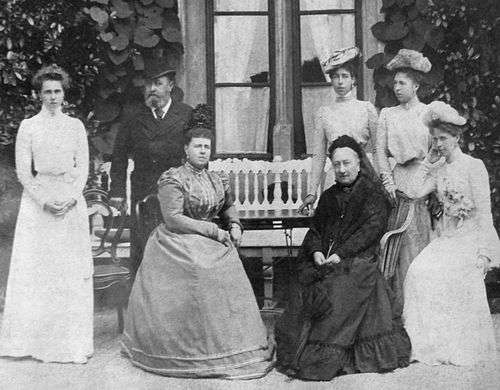 |
| Picture | Name | Birth | Death | Notes[3] |
|---|---|---|---|---|
 | Prince Alfred, later Hereditary Prince of Saxe-Coburg and Gotha | 15 October 1874 Buckingham Palace, London | 6 February 1899 Martinnsbrunn Sanatorium, Gratsch, Merano (Meran), Austria | Rumoured, but never proven to have married in 1898 Mabel Fitzgerald (with no issue). ¶ Alfred suffered from nervous depression and possibly syphilis. He attempted suicide by shooting himself with a revolver, and was sent to recover at Schloss (Castle) Friedenstein in Gotha, Germany, before being moved, while still badly wounded, to the Martinnsbrunn Sanatorium in Gratsch near Merano (Meran) in the South Tyrol (Austria, now Italy), where he died. |
 | Princess Marie of Edinburgh, later Queen of Romania | 29 October 1875 Eastwell Park, Kent | 18 July 1938 Sinaia, Romania | Married 1893 Ferdinand of Romania (1865–1927), — later King Ferdinand (1914–1927), and had issue (3 sons, 3 daughters): Crown Prince Carol (1893–1953), later King Carol II (1930–40), father of King Michael, Princess Elisabeta (1894–1956), later Queen of Greece, Princess Marie (1900–1961), later Queen of Yugoslavia and mother of King Peter II of Yugoslavia, Prince Nicholas (1903–1978), Princess Ileana (1909–1991), and Prince Mircea (1913–1916). |
| |
Princess Victoria Melita later Grand Duchess Victoria Feodorovna of Russia |
25 November 1876 San Antonio Palace, Malta |
2 March 1936 Amorbach, Bavaria, Germany |
Married 1894 (1) her paternal first cousin, Ernest Louis (1868–1937), Grand Duke of Hesse (1892–1918), the son of her aunt Princess Alice (see above), and had issue (1 stillborn son, 1 daughter): Princess Elisabeth (1895–1903) and an unnamed stillborn son (1900). ¶ The marriage ended in divorce in 1901. |
| Married (2) 1905, her maternal first cousin, Grand Duke Cyril Vladimirovich of Russia (1876–1938) and had issue (1 son, 2 daughters): Princess Maria Kirillovna (1907–1951), Princess Kira Kirillovna (1909–1967) and Prince Vladimir Kirillovich (1917–1992). | ||||
 | Princess Alexandra | 1 September 1878 Rosenau Castle, Coburg, Germany | 16 April 1942 Schwäbisch Hall, Germany | Married 1896 Prince Ernest II of Hohenlohe-Langenburg (1863–1950) and had issue (2 sons, 3 daughters): Prince Gottfried of Hohenlohe-Langenburg (1897–1960), Princess Marie-Melita (1899–1967), Princess Alexandra Beatrice (1901–1963), Princess Irma (1902–1986), and Prince Alfred (16–18 April 1911) ¶ The senior Princess Alexandra joined the National Socialist German Workers Party (NSDAP) in 1937. |
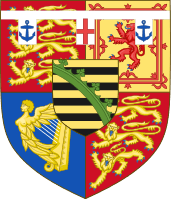 | Stillborn son | 13 October 1879 Eastwell Park, Kent, England | 13 October 1879 Eastwell Park, Kent, England | Died at birth. |
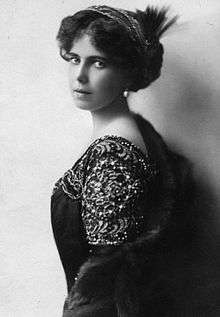 | Princess Beatrice | 20 April 1884 Eastwell Park, Kent, England | 13 July 1966 Sanlúcar de Barrameda, Spain | Married 1909 Prince Alfonso de Orléans y Borbón, Duke of Galliera (1886–1975), Spanish Air Force chief of staff, and had issue (3 sons): Prince Álvaro de Orléans (1910–1997), later Duke of Galliera, Prince Alonso de Orléans (1912–1936) and Prince Araulfo de Orléans (1913–1974). |
Princess Helena
Princess Helena (1846–1923) married Prince Christian of Schleswig-Holstein (1831–1917) in Windsor Castle's private chapel on 5 July 1866. Two sons and two daughters survived childhood; two other sons died within ten days of their birth. Princess Helena and Prince Christian had no legitimate grandchildren and one natural granddaughter who died without having issue of her own. Like other British royal holders of German titles (such as Admiral Louis Battenberg), Princess Helena, Prince Christian, and their two daughters gave up their titles to Schleswig-Holstein in 1917 when the British and German Empires were at war.
| The Marriage of Princess Helena and Prince Christian of Schleswig-Holstein | ||||
| Name | Birth | Death | Marriage and children | |
|---|---|---|---|---|
 |
Princess Helena | 25 May 1846 Buckingham Palace, London, England |
9 June 1923 Schomberg House, London, England |
Married 5 July 1866 in Windsor Castle, Windsor, Berkshire. 4 sons (of whom 2 survived their first month), 2 daughters (including Duke Albert, Princess Helena Victoria, and Princess Marie Louise of Schleswig-Holstein); 1 natural granddaughter (Valerie Marie zu Schleswig-Holstein, Duchess of Arenberg) ¶ Princess Helena and Prince Christian have no surviving descendants today; Valerie Marie died childless. |
 |
Prince Christian of Schleswig-Holstein | 22 January 1831 Augustenborg, Denmark |
28 October 1917 Schomberg House, London, England | |
| Ancestors of Prince Christian of Schleswig-Holstein | |||||||||||||||||||||||||||||||||||||||||||||||||||||||||||||||||||||||||||||||||||||||||||||||||||||||||||||||||||||||||||||||||||||||||||||||||||||||||||||||||||||||||||||||||||||||||||||||||||||||||||||||||||||||||||||||||||||||||||||||||||||||||||||||||||||||||||||||||||||||||||||||||||||||||||||||||||||||||||||||||||||||||||||||||||||||||||||||||||||||||||||||||||||||||||||||||||||||||||||||||||||||||||||||||||||||||||||||||||||||||||||||||||||||||||||||||||||||||||||||||||||||||||||||||||||||||||||||||||||||||||||||||||||||||||||||||||||||||||||||||||||||||||||||||||||||||||||||||||||||||||||||||||||||||||||||||||||||||||||||||||||||||||||||||||||||||||||||||||||||||||||||||||||||||||||||||||||||||||||||||||||||||||||||||||||||||||||||||||||||||||||||||||||||||||||||||||||||||||||||||||||||||||||||||||||||||||||||||||||||||||||||||||||||||||||||||||||||||||||||||||||||||||||||||||||||||||||||||||||||||||||||||||||||||||||||||||||||||||||||||||||||||||||||||||||||||||||||||||||||
|---|---|---|---|---|---|---|---|---|---|---|---|---|---|---|---|---|---|---|---|---|---|---|---|---|---|---|---|---|---|---|---|---|---|---|---|---|---|---|---|---|---|---|---|---|---|---|---|---|---|---|---|---|---|---|---|---|---|---|---|---|---|---|---|---|---|---|---|---|---|---|---|---|---|---|---|---|---|---|---|---|---|---|---|---|---|---|---|---|---|---|---|---|---|---|---|---|---|---|---|---|---|---|---|---|---|---|---|---|---|---|---|---|---|---|---|---|---|---|---|---|---|---|---|---|---|---|---|---|---|---|---|---|---|---|---|---|---|---|---|---|---|---|---|---|---|---|---|---|---|---|---|---|---|---|---|---|---|---|---|---|---|---|---|---|---|---|---|---|---|---|---|---|---|---|---|---|---|---|---|---|---|---|---|---|---|---|---|---|---|---|---|---|---|---|---|---|---|---|---|---|---|---|---|---|---|---|---|---|---|---|---|---|---|---|---|---|---|---|---|---|---|---|---|---|---|---|---|---|---|---|---|---|---|---|---|---|---|---|---|---|---|---|---|---|---|---|---|---|---|---|---|---|---|---|---|---|---|---|---|---|---|---|---|---|---|---|---|---|---|---|---|---|---|---|---|---|---|---|---|---|---|---|---|---|---|---|---|---|---|---|---|---|---|---|---|---|---|---|---|---|---|---|---|---|---|---|---|---|---|---|---|---|---|---|---|---|---|---|---|---|---|---|---|---|---|---|---|---|---|---|---|---|---|---|---|---|---|---|---|---|---|---|---|---|---|---|---|---|---|---|---|---|---|---|---|---|---|---|---|---|---|---|---|---|---|---|---|---|---|---|---|---|---|---|---|---|---|---|---|---|---|---|---|---|---|---|---|---|---|---|---|---|---|---|---|---|---|---|---|---|---|---|---|---|---|---|---|---|---|---|---|---|---|---|---|---|---|---|---|---|---|---|---|---|---|---|---|---|---|---|---|---|---|---|---|---|---|---|---|---|---|---|---|---|---|---|---|---|---|---|---|---|---|---|---|---|---|---|---|---|---|---|---|---|---|---|---|---|---|---|---|---|---|---|---|---|---|---|---|---|---|---|---|---|---|---|---|---|---|---|---|---|---|---|---|---|---|---|---|---|---|---|---|---|---|---|---|---|---|---|---|---|---|---|---|---|---|---|---|---|---|---|---|---|---|---|---|---|---|---|---|---|---|---|---|---|---|---|---|---|---|---|---|---|---|---|---|---|---|---|---|---|---|---|---|---|---|---|---|---|---|---|---|---|---|---|---|---|---|---|---|---|---|---|---|---|---|---|---|---|---|---|---|---|---|---|---|---|---|---|---|---|---|---|---|---|---|---|---|---|---|---|---|---|---|---|---|---|---|---|---|---|---|---|---|---|---|---|---|---|---|---|---|---|---|---|---|---|---|---|---|---|---|---|---|---|---|---|---|---|---|---|---|---|---|---|---|---|---|---|---|---|---|---|---|---|---|---|---|---|---|---|---|---|---|---|---|---|---|---|---|---|---|---|---|---|---|---|---|---|---|---|---|---|---|---|---|---|---|---|---|---|---|---|---|---|---|---|---|---|---|---|---|---|---|---|---|---|---|---|---|---|---|---|---|---|---|---|---|---|---|---|---|---|---|---|---|---|---|---|---|---|---|---|---|---|---|---|---|---|---|---|---|---|---|---|---|---|---|---|---|---|---|---|---|---|---|---|---|---|---|---|---|---|---|---|---|---|---|---|---|---|---|---|---|---|---|---|---|---|---|---|---|---|---|---|---|---|---|---|---|---|---|---|---|---|---|---|---|---|---|---|---|---|---|---|---|---|---|---|---|---|---|---|---|---|---|---|---|---|---|---|---|---|---|---|---|---|---|---|---|---|---|---|---|---|---|---|---|---|---|---|---|---|---|---|---|---|---|---|---|---|---|---|---|---|---|---|---|---|---|---|---|---|---|---|---|---|---|---|---|---|---|---|---|---|---|---|---|---|---|---|---|---|---|---|---|---|---|---|---|---|---|---|---|---|---|---|---|---|---|---|---|---|---|---|---|---|---|---|---|---|---|---|---|---|---|---|---|---|---|---|---|---|---|---|---|---|---|---|---|---|---|---|---|---|---|---|---|---|---|---|---|---|---|---|---|---|---|---|---|---|---|---|---|---|---|---|---|---|---|---|---|---|---|---|---|---|---|---|---|---|---|---|---|---|---|---|---|---|---|---|---|---|---|---|---|---|---|---|---|---|---|---|---|---|---|---|---|
|
<td rowspan="2" " style="border-left: 1px solid black;">
| |||||||||||||||||||||||||||||||||||||||||||||||||||||||||||||||||||||||||||||||||||||||||||||||||||||||||||||||||||||||||||||||||||||||||||||||||||||||||||||||||||||||||||||||||||||||||||||||||||||||||||||||||||||||||||||||||||||||||||||||||||||||||||||||||||||||||||||||||||||||||||||||||||||||||||||||||||||||||||||||||||||||||||||||||||||||||||||||||||||||||||||||||||||||||||||||||||||||||||||||||||||||||||||||||||||||||||||||||||||||||||||||||||||||||||||||||||||||||||||||||||||||||||||||||||||||||||||||||||||||||||||||||||||||||||||||||||||||||||||||||||||||||||||||||||||||||||||||||||||||||||||||||||||||||||||||||||||||||||||||||||||||||||||||||||||||||||||||||||||||||||||||||||||||||||||||||||||||||||||||||||||||||||||||||||||||||||||||||||||||||||||||||||||||||||||||||||||||||||||||||||||||||||||||||||||||||||||||||||||||||||||||||||||||||||||||||||||||||||||||||||||||||||||||||||||||||||||||||||||||||||||||||||||||||||||||||||||||||||||||||||||||||||||||||||||||||||||||||||||||
Children of Princess Helena and Prince Christian of Schleswig-Holstein
| Photograph of Princess Helena with her two eldest children by Alexander Bassano |
|---|
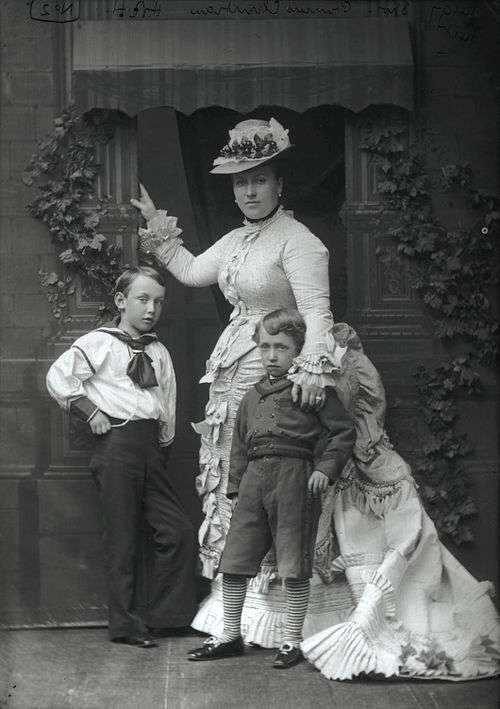 |
| Picture | Name | Birth | Death | Notes[3] |
|---|---|---|---|---|
 | Prince Christian Victor of Schleswig-Holstein | 14 August 1867 Windsor Castle, Berkshire, England | 29 October 1900 Pretoria, South Africa | Christian Victor died of malaria while serving as a British officer on active duty in the Boer War. |
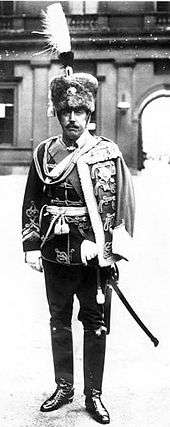 | Prince Albert, later Duke of Schleswig-Holstein | 28 February 1869 Frogmore House, Windsor, Berkshire | 13 March 1931 Berlin, Germany | Succeeded as head of the House of Oldenburg in 1921. Never married, but had a twice-married and childless natural daughter, Valerie Marie zu Schleswig-Holstein (née Schwalb) (1900–1953), |
 | Princess Helena Victoria, until 1917: Princess of Schleswig-Holstein | 3 May 1870 Frogmore House, Windsor, Berkshire | 13 March 1948 Berkeley Square, London, England | Died unmarried. |
 | Princess Marie Louise, until 1917: Princess of Schleswig-Holstein | 12 August 1872 Cumberland Lodge, Windsor, Berkshire | 8 December 1956 Berkeley Square, London, England | Married 1891 to Prince Aribert of Anhalt (1866–1933); no issue; marriage was dissolved in 1900. |
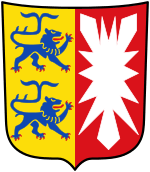 | Prince Harald of Schleswig-Holstein[12] | 12 May 1876 Cumberland Lodge, Windsor, Berkshire | 20 May 1876 Cumberland Lodge, Windsor, Berkshire | Died in infancy. |
 | Stillborn son | 7 May 1877 | 7 May 1877 | Died at birth. |
Princess Louise
Princess Louise (1848–1939), who married John Campbell, 9th Duke of Argyll (1845–1914) in 1871, was the only one of Victoria's nine children who was childless. She was the first British monarch's child since 1515 to marry a subject rather than someone of royal blood.
| The Marriage of Princess Louise and John Campbell, Marquess of Lorne | ||||
| Name | Birth | Death | Notes | |
|---|---|---|---|---|
 |
The Princess Louise | 18 March 1848 Buckingham Palace, Westminster (London) |
3 December 1939 Kensington Palace, London |
Married 21 March 1871, in St. George's Chapel, Windsor Castle (Berkshire) no issue ¶ The Marquess of Lorne was a member of the British House of Commons from 1868 to 1878 and from 1895 to 1900. From 1878 to 1883 he served as Governor General of Canada, representing his mother-in-law, Queen Victoria. In 1900, he succeeded as 9th Duke of Argyll (and thus joined the House of Lords). |
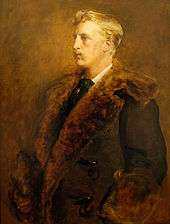 |
John Douglas Sutherland Campbell, M.P., Marquess of Lorne, later Governor General of Canada, later 9th Duke of Argyll |
6 August 1845 London |
2 May 1914 Cowes, Isle of Wight | |
| Ancestors of John Campbell, Marquess of Lorne and 9th Duke of Argyll | |||||||||||||||||||||||||||||||||||||||||||||||||||||||||||||||||||||||||||||||||||||||||||||||||||||||||||||||||||||||||||||||||||||||||||||||||||||||||||||||||||||||||||||||||||||||||||||||||||||||||||||||||||||||||||||||||||||||||||||||||||||||||||||||||||||||||||||||||||||||||||||||||||||||||||||||||||||||||||||||||||||||||||||||||||||||||||||||||||||||||||||||||||||||||||||||||||||||||||||||||||||||||||||||||||||||||||||||||||||||||||||||||||||||||||||||||||||||||||||||||
|---|---|---|---|---|---|---|---|---|---|---|---|---|---|---|---|---|---|---|---|---|---|---|---|---|---|---|---|---|---|---|---|---|---|---|---|---|---|---|---|---|---|---|---|---|---|---|---|---|---|---|---|---|---|---|---|---|---|---|---|---|---|---|---|---|---|---|---|---|---|---|---|---|---|---|---|---|---|---|---|---|---|---|---|---|---|---|---|---|---|---|---|---|---|---|---|---|---|---|---|---|---|---|---|---|---|---|---|---|---|---|---|---|---|---|---|---|---|---|---|---|---|---|---|---|---|---|---|---|---|---|---|---|---|---|---|---|---|---|---|---|---|---|---|---|---|---|---|---|---|---|---|---|---|---|---|---|---|---|---|---|---|---|---|---|---|---|---|---|---|---|---|---|---|---|---|---|---|---|---|---|---|---|---|---|---|---|---|---|---|---|---|---|---|---|---|---|---|---|---|---|---|---|---|---|---|---|---|---|---|---|---|---|---|---|---|---|---|---|---|---|---|---|---|---|---|---|---|---|---|---|---|---|---|---|---|---|---|---|---|---|---|---|---|---|---|---|---|---|---|---|---|---|---|---|---|---|---|---|---|---|---|---|---|---|---|---|---|---|---|---|---|---|---|---|---|---|---|---|---|---|---|---|---|---|---|---|---|---|---|---|---|---|---|---|---|---|---|---|---|---|---|---|---|---|---|---|---|---|---|---|---|---|---|---|---|---|---|---|---|---|---|---|---|---|---|---|---|---|---|---|---|---|---|---|---|---|---|---|---|---|---|---|---|---|---|---|---|---|---|---|---|---|---|---|---|---|---|---|---|---|---|---|---|---|---|---|---|---|---|---|---|---|---|---|---|---|---|---|---|---|---|---|---|---|---|---|---|---|---|---|---|---|---|---|---|---|---|---|---|---|---|---|---|---|---|---|---|---|---|---|---|---|---|---|---|---|---|---|---|---|---|---|---|---|---|---|---|---|---|---|---|---|---|---|---|---|---|---|---|---|---|---|---|---|---|---|---|---|---|---|---|---|---|---|---|---|---|---|---|---|---|---|---|---|---|---|---|---|---|---|---|---|---|---|---|---|---|---|---|---|---|
| |||||||||||||||||||||||||||||||||||||||||||||||||||||||||||||||||||||||||||||||||||||||||||||||||||||||||||||||||||||||||||||||||||||||||||||||||||||||||||||||||||||||||||||||||||||||||||||||||||||||||||||||||||||||||||||||||||||||||||||||||||||||||||||||||||||||||||||||||||||||||||||||||||||||||||||||||||||||||||||||||||||||||||||||||||||||||||||||||||||||||||||||||||||||||||||||||||||||||||||||||||||||||||||||||||||||||||||||||||||||||||||||||||||||||||||||||||||||||||||||||
Prince Arthur, Duke of Connaught
Prince Arthur (1850–1942) married Princess Louise Margaret of Prussia (1860–1917) on 13 March 1879 at St George's Chapel in Windsor Castle. They had 2 daughters and 1 son.
In March 1911, the Duke of Connaught's nephew, King George V (son of the Duke's recently deceased brother King Edward VII) appointed his uncle to represent him as Governor General of Canada. He thus became the first, and so far only, Governor General of Canada to be of the Blood Royal, although he had been preceded in this office from 1878 to 1883 by the Marquess of Lorne, the non-royal husband of his sister Princess Louise (see above). [King George's son, the Duke of Gloucester, was later Governor-General of Australia, and the Duke of Connaught's own son was later Governor-General of South Africa. See above and below.]
Prince Arthur's elder daughter (and Queen Victoria's granddaughter) Princess Margaret of Connaught became Crown Princess of Sweden in 1907 after marrying the future King Gustaf VI Adolf of Sweden in 1905 (however, Margaret died before Gustav became king).
- Princess Margaret and Prince Gustav Adolf's grandson (and a great-great-grandson of Victoria) King Carl XVI Gustav of Sweden is the current monarch of Sweden having reigned from 1973. He is the youngest and only son of Prince Gustav Adolf, Duke of Västerbotten.
- Their only daughter (and Victoria's great-granddaughter) Princess Ingrid of Sweden married King Frederick IX of Denmark (reigned 1947–1972) and was the mother of the present Queen Margrethe II of Denmark and the former Queen Anne-Marie of Greece, great-great-granddaughters of Queen Victoria.
- Their youngest son, Count Carl Johan Bernadotte of Wisborg (1916-2012), was the last great-grandchild of Victoria and Albert to die
Queen Victoria → Prince Arthur → Princess Margaret → Prince Gustav Adolf, Duke of Västerbotten → King Carl XVI Gustav
Queen Victoria → Prince Arthur → Princess Margaret → Princess Ingrid → Danish Queen Margrethe II & Greek Queen Anne-Marie
Queen Victoria → Prince Arthur → Princess Margaret → Count Carl Johan Bernadotte
| The Marriage of Arthur, Duke of Connaught, and Princess Louise Margaret of Prussia | ||||
| Name | Birth | Death | Notes | |
|---|---|---|---|---|
 |
The Prince Arthur, Duke of Connaught and Strathearn Field Marshal, Governor General of Canada |
1 May 1850 Buckingham Palace, Westminster (London) |
16 January 1942 Bagshot Park, Surrey |
Married 13 March 1879 in St. George's Chapel of Windsor Castle (Berkshire) 1 son, 2 daughters 6 grandsons, 1 granddaughter (including Queen Ingrid of Denmark and Count Carl Johan Bernadotte, the last great-grandchild of Queen Victoria to die) ¶ The Duke of Connaught was made a Field Marshal in 1902 and served as Governor General of Canada (representing his nephew King George V) from 1911 to 1916. |
 |
Princess Louise Margaret of Prussia | 25 July 1860 Potsdam, Germany |
14 March 1917 Clarence House, Westminster (London) | |
| Ancestors of Princess Louise Margaret of Prussia | |||||||||||||||||||||||||||||||||||||||||||||||||||||||||||||||||||||||||||||||||||||||||||||||||||||||||||||||||||||||||||||||||||||||||||||||||||||||||||||||||||||||||||||||||||||||||||||||||||||||||||||||||||||||||||||||||||||||||||||||||||||||||||||||||||||||||||||||||||||||||||||||||||||||||||||||||||||||||||||||||||||||||||||||||||||||||||||||||||||||||||||||||||||||||||||||||||||||||||||||||||||||||||||||||||||||||||||||||||||||||||||||||||||||||||||||||||||||||||||||||||||||||||||||||||||||||||||||||||||||||||||||||||||||||||||||||||||||||||||||||||||||||||||||||||||||||||||||||||||||||||||||||||||||||||||||||||||||||||||||||||||||||||||||||||||||||||||||||||||||||||||||||||||||||||||||||||||||||||||||||||||||||||||||||||||||||||||||||||||||||||||||||||||||||||||||||||||||||||||||||||||||||||||||||||||||||||||||||||||||||||||||||||||||||||||||||||||||||||||||||||||||||||||||||||||||||||||||||||||||||||||||||||||||||||||||||||||||||||||||||||||||||||||||||||||||||||||||||||||||
|---|---|---|---|---|---|---|---|---|---|---|---|---|---|---|---|---|---|---|---|---|---|---|---|---|---|---|---|---|---|---|---|---|---|---|---|---|---|---|---|---|---|---|---|---|---|---|---|---|---|---|---|---|---|---|---|---|---|---|---|---|---|---|---|---|---|---|---|---|---|---|---|---|---|---|---|---|---|---|---|---|---|---|---|---|---|---|---|---|---|---|---|---|---|---|---|---|---|---|---|---|---|---|---|---|---|---|---|---|---|---|---|---|---|---|---|---|---|---|---|---|---|---|---|---|---|---|---|---|---|---|---|---|---|---|---|---|---|---|---|---|---|---|---|---|---|---|---|---|---|---|---|---|---|---|---|---|---|---|---|---|---|---|---|---|---|---|---|---|---|---|---|---|---|---|---|---|---|---|---|---|---|---|---|---|---|---|---|---|---|---|---|---|---|---|---|---|---|---|---|---|---|---|---|---|---|---|---|---|---|---|---|---|---|---|---|---|---|---|---|---|---|---|---|---|---|---|---|---|---|---|---|---|---|---|---|---|---|---|---|---|---|---|---|---|---|---|---|---|---|---|---|---|---|---|---|---|---|---|---|---|---|---|---|---|---|---|---|---|---|---|---|---|---|---|---|---|---|---|---|---|---|---|---|---|---|---|---|---|---|---|---|---|---|---|---|---|---|---|---|---|---|---|---|---|---|---|---|---|---|---|---|---|---|---|---|---|---|---|---|---|---|---|---|---|---|---|---|---|---|---|---|---|---|---|---|---|---|---|---|---|---|---|---|---|---|---|---|---|---|---|---|---|---|---|---|---|---|---|---|---|---|---|---|---|---|---|---|---|---|---|---|---|---|---|---|---|---|---|---|---|---|---|---|---|---|---|---|---|---|---|---|---|---|---|---|---|---|---|---|---|---|---|---|---|---|---|---|---|---|---|---|---|---|---|---|---|---|---|---|---|---|---|---|---|---|---|---|---|---|---|---|---|---|---|---|---|---|---|---|---|---|---|---|---|---|---|---|---|---|---|---|---|---|---|---|---|---|---|---|---|---|---|---|---|---|---|---|---|---|---|---|---|---|---|---|---|---|---|---|---|---|---|---|---|---|---|---|---|---|---|---|---|---|---|---|---|---|---|---|---|---|---|---|---|---|---|---|---|---|---|---|---|---|---|---|---|---|---|---|---|---|---|---|---|---|---|---|---|---|---|---|---|---|---|---|---|---|---|---|---|---|---|---|---|---|---|---|---|---|---|---|---|---|---|---|---|---|---|---|---|---|---|---|---|---|---|---|---|---|---|---|---|---|---|---|---|---|---|---|---|---|---|---|---|---|---|---|---|---|---|---|---|---|---|---|---|---|---|---|---|---|---|---|---|---|---|---|---|---|---|---|---|---|---|---|---|---|---|---|---|---|---|---|---|---|---|---|---|---|---|---|---|---|---|---|---|---|---|---|---|---|---|---|---|---|---|---|---|---|---|---|---|---|---|---|---|---|---|---|---|---|---|---|---|---|---|---|---|---|---|---|---|---|---|---|---|---|---|---|---|---|---|---|---|---|---|---|---|---|---|---|---|---|---|---|---|---|---|---|---|---|---|---|---|---|---|---|---|---|---|---|---|---|---|---|---|---|---|---|---|---|---|---|---|---|---|---|---|---|---|---|---|---|---|---|---|---|---|---|---|---|---|---|---|---|---|---|---|---|---|---|---|---|---|---|---|---|---|---|---|---|---|---|---|---|---|---|---|---|---|---|---|---|---|---|---|---|---|---|---|---|---|---|---|---|---|---|---|---|---|---|---|---|---|---|---|---|---|---|---|---|---|---|---|---|---|---|---|---|---|---|---|---|---|---|---|---|---|---|---|---|---|---|---|---|---|---|---|---|---|---|---|---|---|---|---|---|---|---|---|---|---|---|---|---|---|---|---|---|---|---|---|---|---|---|---|---|---|---|---|---|---|---|---|---|---|---|---|---|---|---|---|---|---|---|---|---|---|---|---|---|---|---|---|---|---|---|---|---|---|---|---|---|---|---|---|---|---|---|---|---|---|---|---|---|---|---|---|---|---|---|---|---|---|---|---|---|---|---|---|---|---|---|---|---|---|---|---|---|---|---|---|---|---|---|---|---|---|---|---|---|---|---|---|---|---|---|---|---|---|---|---|---|---|---|---|---|---|---|---|---|---|---|---|---|---|---|---|---|---|---|---|---|---|---|---|---|---|---|---|---|---|---|---|---|---|---|---|---|---|---|---|---|---|---|---|---|---|---|
|
<td rowspan="2" " style="border-left: 1px solid black;">
| |||||||||||||||||||||||||||||||||||||||||||||||||||||||||||||||||||||||||||||||||||||||||||||||||||||||||||||||||||||||||||||||||||||||||||||||||||||||||||||||||||||||||||||||||||||||||||||||||||||||||||||||||||||||||||||||||||||||||||||||||||||||||||||||||||||||||||||||||||||||||||||||||||||||||||||||||||||||||||||||||||||||||||||||||||||||||||||||||||||||||||||||||||||||||||||||||||||||||||||||||||||||||||||||||||||||||||||||||||||||||||||||||||||||||||||||||||||||||||||||||||||||||||||||||||||||||||||||||||||||||||||||||||||||||||||||||||||||||||||||||||||||||||||||||||||||||||||||||||||||||||||||||||||||||||||||||||||||||||||||||||||||||||||||||||||||||||||||||||||||||||||||||||||||||||||||||||||||||||||||||||||||||||||||||||||||||||||||||||||||||||||||||||||||||||||||||||||||||||||||||||||||||||||||||||||||||||||||||||||||||||||||||||||||||||||||||||||||||||||||||||||||||||||||||||||||||||||||||||||||||||||||||||||||||||||||||||||||||||||||||||||||||||||||||||||||||||||||||||||||
Children of Arthur, Duke of Connaught, and Princess Louise Margaret of Prussia
| Photograph of The Duke of Connaught's family. |
|---|
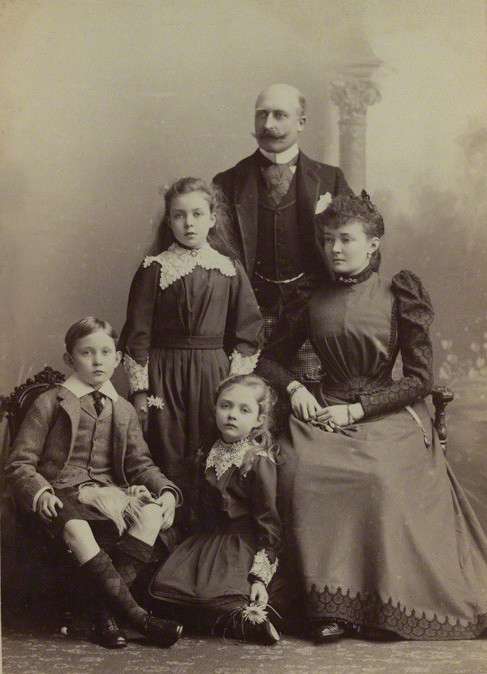 |
| Picture | Name | Birth | Death | Notes[3] |
|---|---|---|---|---|
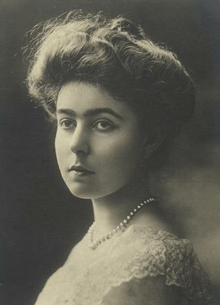 | Princess Margaret of Connaught | 15 January 1882 Bagshot Park, Surrey | 1 May 1920 Stockholm, Sweden | Married 1905 Prince Gustaf Adolf of Sweden (1882–1973) — later King Gustav VI (1950–1973) and had issue (4 sons, 1 daughter): Prince Gustav Adolf, Duke of Västerbotten (1906–1947) — father of King Carl XVI Gustav, Prince Sigvard, Duke of Uppland (1907–2002), — later Count Sigvard Bernadotte of Wisborg Princess Ingrid (1910–2000), later Queen of Denmark, mother of Queen Margrethe II of Denmark, and mother of Queen Anne-Marie of Greece, Prince Bertil, Duke of Halland (1912–1997), and Prince Carl Johan, Duke of Dalarna (1916–2012), — later Count Carl Johan Bernadotte of Wisborg and, after 2007, the last surviving great-grandchild of Queen Victoria. Princess Margaret died suddenly on her father's 70th birthday of meningitis while 8 months pregnant with her sixth child before her husband ascended the throne as King of Sweden. |
 | Prince Arthur of Connaught, Governor-General of the Union of South Africa (1920–24) | 13 January 1883 Windsor Castle, Berkshire | 12 September 1938 London, England | Married 1913 Princess Alexandra, Duchess of Fife (1891–1959), granddaughter of Edward VII (her husband's uncle) and thus Arthur's first cousin once removed, having issue (1 son): Prince Alastair (1914–1943), later 2nd Duke of Connaught. ¶ Prince Arthur became the third Governor General of South Africa in November 1920, and was succeeded in January 1924 by Alexander Cambridge, 1st Earl of Athlone, husband of his cousin, Princess Alice of Albany (see below). |
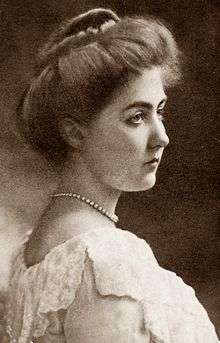 | Princess Patricia of Connaught, later Lady Patricia Ramsay | 17 March 1886 Buckingham Palace, Westminster (London) | 12 January 1974 Windlesham, Surrey | Married 1919 the Honourable Alexander Ramsay (1881–1972) and had issue (1 son): Alexander Ramsay of Mar (1919–2000). ¶ Princess Patricia relinquished her title of Princess and style of Her Royal Highness upon her marriage and was known as Lady Patricia Ramsay. (However, she kept her place in line of succession.) |
Prince Leopold, Duke of Albany
Prince Leopold (1853–1884) married Princess Helena of Waldeck and Pyrmont (1861–1922) on 27 April 1882 at St George's Chapel, Windsor Castle. They had 1 daughter and 1 son. He inherited the disease of haemophilia from his mother, Queen Victoria, and spent most of his life as a semi-invalid.
His daughter, Princess Alice of Albany married Prince Alexander of Teck, the younger brother of Queen Mary, in 1904 and became Countess of Athlone when her husband was created Earl of Athlone in June 1917. She has so far been the longest-lived Princess of the Blood Royal of Britain and was the last surviving grandchild of Queen Victoria.
Prince Charles Edward, Prince Leopold's posthumous son, succeeded him at birth as 2nd Duke of Albany. In 1900, Charles Edward succeeded his uncle Alfred as Duke of Saxe-Coburg and Gotha but was forced to abdicate his ducal throne during the German Revolution of 1918, later gaining high positions in and through the Nazi movement. Because of his support for Germany in World War I, he lost his English knighthood in the Order of the Garter in 1915 and his British royal titles, peerages and honours in 1919. He is the grandfather of King Carl XVI Gustaf of Sweden through his elder daughter, Princess Sibylla.
Queen Victoria → Prince Leopold → Prince Charles Edward → Princess Sibylla → King Carl XVI Gustav
| The Marriage of Leopold, Duke of Albany, and Princess Helena of Waldeck and Pyrmont | ||||
| Name | Birth | Death | Notes | |
|---|---|---|---|---|
 |
Prince Leopold, Duke of Albany |
7 April 1853 Buckingham Palace, Westminster (London) |
28 March 1884 Cannes, France |
Married 27 April 1882 in St. George's Chapel of Windsor Castle (Berkshire) 1 son, 1 daughter 5 grandsons, 3 granddaughters |
 |
Princess Helena of Waldeck and Pyrmont | 17 February 1861 Arolsen, Waldeck (now Hesse, Germany) |
1 September 1922 Hinteriss, Tyrol, Austria | |
| Ancestors of Princess Helena of Waldeck and Pyrmont | |||||||||||||||||||||||||||||||||||||||||||||||||||||||||||||||||||||||||||||||||||||||||||||||||||||||||||||||||||||||||||||||||||||||||||||||||||||||||||||||||||||||||||||||||||||||||||||||||||||||||||||||||||||||||||||||||||||||||||||||||||||||||||||||||||||||||||||||||||||||||||||||||||||||||||||||||||||||||||||||||||||||||||||||||||||||||||||||||||||||||||||||||||||||||||||||||||||||||||||||||||||||||||||||||||||||||||||||||||||||||||||||||||||||||||||||||||||||||||||||||||||||||||||||||||||||||||||||||||||||||||||||||||||||||||||||||||||||||||||||||||||||||||||||||||||||||||||||||||||||||||||||||||||||||||||||||||||||||||||||||||||||||||||||||||||||||||||||||||||||||||||||||||||||||||||||||||||||||||||||||||||||||||||||||||||||||||||||||||||||||||||||||||||||||||||||||||||||||||||||||||||||||||||||||||||||||||||||||||||||||||||||||||||||||||||||||||||||||||||||||||||||||||||||||||||||||||||||||||||||||||||||||||||||||||||||||||||||||||||||||||||||||||||||||||||||||||||||||||||||
|---|---|---|---|---|---|---|---|---|---|---|---|---|---|---|---|---|---|---|---|---|---|---|---|---|---|---|---|---|---|---|---|---|---|---|---|---|---|---|---|---|---|---|---|---|---|---|---|---|---|---|---|---|---|---|---|---|---|---|---|---|---|---|---|---|---|---|---|---|---|---|---|---|---|---|---|---|---|---|---|---|---|---|---|---|---|---|---|---|---|---|---|---|---|---|---|---|---|---|---|---|---|---|---|---|---|---|---|---|---|---|---|---|---|---|---|---|---|---|---|---|---|---|---|---|---|---|---|---|---|---|---|---|---|---|---|---|---|---|---|---|---|---|---|---|---|---|---|---|---|---|---|---|---|---|---|---|---|---|---|---|---|---|---|---|---|---|---|---|---|---|---|---|---|---|---|---|---|---|---|---|---|---|---|---|---|---|---|---|---|---|---|---|---|---|---|---|---|---|---|---|---|---|---|---|---|---|---|---|---|---|---|---|---|---|---|---|---|---|---|---|---|---|---|---|---|---|---|---|---|---|---|---|---|---|---|---|---|---|---|---|---|---|---|---|---|---|---|---|---|---|---|---|---|---|---|---|---|---|---|---|---|---|---|---|---|---|---|---|---|---|---|---|---|---|---|---|---|---|---|---|---|---|---|---|---|---|---|---|---|---|---|---|---|---|---|---|---|---|---|---|---|---|---|---|---|---|---|---|---|---|---|---|---|---|---|---|---|---|---|---|---|---|---|---|---|---|---|---|---|---|---|---|---|---|---|---|---|---|---|---|---|---|---|---|---|---|---|---|---|---|---|---|---|---|---|---|---|---|---|---|---|---|---|---|---|---|---|---|---|---|---|---|---|---|---|---|---|---|---|---|---|---|---|---|---|---|---|---|---|---|---|---|---|---|---|---|---|---|---|---|---|---|---|---|---|---|---|---|---|---|---|---|---|---|---|---|---|---|---|---|---|---|---|---|---|---|---|---|---|---|---|---|---|---|---|---|---|---|---|---|---|---|---|---|---|---|---|---|---|---|---|---|---|---|---|---|---|---|---|---|---|---|---|---|---|---|---|---|---|---|---|---|---|---|---|---|---|---|---|---|---|---|---|---|---|---|---|---|---|---|---|---|---|---|---|---|---|---|---|---|---|---|---|---|---|---|---|---|---|---|---|---|---|---|---|---|---|---|---|---|---|---|---|---|---|---|---|---|---|---|---|---|---|---|---|---|---|---|---|---|---|---|---|---|---|---|---|---|---|---|---|---|---|---|---|---|---|---|---|---|---|---|---|---|---|---|---|---|---|---|---|---|---|---|---|---|---|---|---|---|---|---|---|---|---|---|---|---|---|---|---|---|---|---|---|---|---|---|---|---|---|---|---|---|---|---|---|---|---|---|---|---|---|---|---|---|---|---|---|---|---|---|---|---|---|---|---|---|---|---|---|---|---|---|---|---|---|---|---|---|---|---|---|---|---|---|---|---|---|---|---|---|---|---|---|---|---|---|---|---|---|---|---|---|---|---|---|---|---|---|---|---|---|---|---|---|---|---|---|---|---|---|---|---|---|---|---|---|---|---|---|---|---|---|---|---|---|---|---|---|---|---|---|---|---|---|---|---|---|---|---|---|---|---|---|---|---|---|---|---|---|---|---|---|---|---|---|---|---|---|---|---|---|---|---|---|---|---|---|---|---|---|---|---|---|---|---|---|---|---|---|---|---|---|---|---|---|---|---|---|---|---|---|---|---|---|---|---|---|---|---|---|---|---|---|---|---|---|---|---|---|---|---|---|---|---|---|---|---|---|---|---|---|---|---|---|---|---|---|---|---|---|---|---|---|---|---|---|---|---|---|---|---|---|---|---|---|---|---|---|---|---|---|---|---|---|---|---|---|---|---|---|---|---|---|---|---|---|---|---|---|---|---|---|---|---|---|---|---|---|---|---|---|---|---|---|---|---|---|---|---|---|---|---|---|---|---|---|---|---|---|---|---|---|---|---|---|---|---|---|---|---|---|---|---|---|---|---|---|---|---|---|---|---|---|---|---|---|---|---|---|---|---|---|---|---|---|---|---|---|---|---|---|---|---|---|---|---|---|---|---|---|---|---|---|---|---|---|---|---|---|---|---|---|---|---|---|---|---|---|---|---|---|---|---|---|---|---|---|---|---|---|---|---|---|---|---|---|---|---|---|---|---|---|---|---|---|---|---|---|---|---|---|---|---|---|---|---|---|---|---|---|---|---|---|---|---|---|---|---|---|---|---|---|---|---|---|---|---|
|
<td rowspan="2" " style="border-left: 1px solid black;">
| |||||||||||||||||||||||||||||||||||||||||||||||||||||||||||||||||||||||||||||||||||||||||||||||||||||||||||||||||||||||||||||||||||||||||||||||||||||||||||||||||||||||||||||||||||||||||||||||||||||||||||||||||||||||||||||||||||||||||||||||||||||||||||||||||||||||||||||||||||||||||||||||||||||||||||||||||||||||||||||||||||||||||||||||||||||||||||||||||||||||||||||||||||||||||||||||||||||||||||||||||||||||||||||||||||||||||||||||||||||||||||||||||||||||||||||||||||||||||||||||||||||||||||||||||||||||||||||||||||||||||||||||||||||||||||||||||||||||||||||||||||||||||||||||||||||||||||||||||||||||||||||||||||||||||||||||||||||||||||||||||||||||||||||||||||||||||||||||||||||||||||||||||||||||||||||||||||||||||||||||||||||||||||||||||||||||||||||||||||||||||||||||||||||||||||||||||||||||||||||||||||||||||||||||||||||||||||||||||||||||||||||||||||||||||||||||||||||||||||||||||||||||||||||||||||||||||||||||||||||||||||||||||||||||||||||||||||||||||||||||||||||||||||||||||||||||||||||||||||||||
Children of Leopold, Duke of Albany, and Princess Helena
| Picture | Name | Birth | Death | Notes[3] |
|---|---|---|---|---|
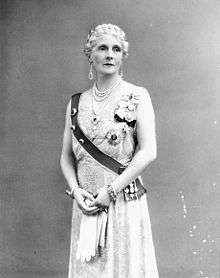 |
Princess Alice of Albany later Countess of Athlone | 25 February 1883 Windsor Castle, Berkshire |
3 January 1981 Kensington Palace, London |
Married 1904 Prince Alexander of Teck (1874–1957), later Alexander Cambridge, 1st Earl of Athlone, Governor-General of South Africa and Canada and had issue (2 sons, 1 daughter): Princess May (1906–1994), Prince Rupert (1907–1928) and Prince Maurice (March–September 1910) |
 |
Prince Charles Edward, Duke of Albany, later Duke of Saxe-Coburg and Gotha |
19 July 1884 Claremont House, Surrey |
6 March 1954 Coburg, Germany |
¶ Last Duke of Saxe-Coburg and Gotha, 1900-1918. Deprived of Duchy of Albany, 1919. Joined 1935 the National Socialist German Workers Party (NSDAP) and SA (Sturmabteilung). Member of the German Reichstag, 1937–1945. Married 1905 Princess Victoria Adelaide of Schleswig-Holstein (1885–1970) and had issue (3 sons, 2 daughters): Hereditary Prince Johann Leopold (1906–1972), Princess Sibylla (1908–1972), later a Swedish princess and mother of King Carl XVI Gustav (acceded 1973) Prince Hubertus (1909–1943), Princess Caroline Mathilde (1912–1983), and Prince Friedrich Josias (1918–1998). |
Princess Beatrice
Princess Beatrice (1857–1944) married Prince Henry of Battenberg (1858–1896) on 23 July 1885 in St. Mildred's Church, Whippingham on the Isle of Wight. They had 3 sons, 1 daughter (the future Queen Victoria Eugenia of Spain), 5 grandsons (1 stillborn) and 3 granddaughters. The present King Felipe VI of Spain, as a great-grandson of Victoria Eugenie, is a great-great-grandson of Princess Beatrice and thus a great-great-great-grandson of Queen Victoria.
Queen Victoria → Princess Beatrice → Queen Victoria Eugenia → Don Juan, Count of Barcelona → King Juan Carlos I of Spain → King Felipe VI
Due to anti-German feeling during the First World War, the members of the Battenberg family who were British citizens relinquished their titles of Prince and Princess of Battenberg and the styles of Highness and Serene Highness. Under Royal Warrant, they instead took the surname Mountbatten, an Anglicised form of Battenberg.
| The Marriage of Princess Beatrice and Prince Henry of Battenberg | ||||
| Name | Birth | Death | Marriage and children | |
|---|---|---|---|---|
 |
Princess Beatrice | 14 April 1857 Buckingham Palace, Westminster (London) |
26 October 1944 Brantridge Park, Sussex |
Married 23 July 1885, at St. Mildred's Church, Whippingham (near Osborne House) on the Isle of Wight 3 sons, 1 daughter (Victoria Eugenie, Queen of Spain) 5 grandsons (one of them stillborn), 3 granddaughters (including Don Juan, Count of Barcelona, Spanish heir-apparent from 1933 to 1969) |
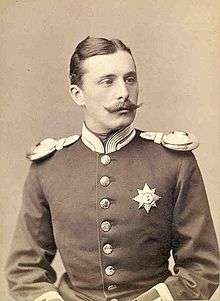 |
Prince Henry of Battenberg | 5 October 1858 Milan, Italy |
20 January 1896 HMS Blonde, near Sierra Leone (West Africa) | |
| Ancestors of Prince Henry of Battenberg | |||||||||||||||||||||||||||||||||||||||||||||||||||||||||||||||||||||||||||||||||||||||||||||||||||||||||||||||||||||||||||||||||||||||||||||||||||||||||||||||||||||||||||||||||||||||||||||||||||||||||||||||||||||||||||||||||||||||||||||||||||||||||||||||||||||||||||||||||||||||||||||||||||||||||||||||||||||||||||||||||||||||||||||||||||||||||||||||||||||||||||||||||||||||||||||||||||||||||||||||||||||||||||||||||||||||||||||||||||||||||||||||||||||||||||||||||||||||||||||||||||||||||||||||||||||||||||||||||||||||||||||||||||||||||||||||||||||||||||||||||||||||||||||||||||||||||||||||||||||||||||||||||||||||||||||||||||||||||||||||||||||||||||||||||||||||||||||||||||||||||||||||||||||||||||||||||||||||||||||||||||||||||||||||||||||||||||||||||||||||||||||||||||||||||||||||||||||||||||||||||||||||||||||||||||||||||||||||||||||||||||||||||||||||||||||||||||||||||||||||||||||||||||||||||||||||||||||||||||||||||||||||||||||||||||||||||||||||||||||||||||||||||||||||||||||||||||||||||||||||
|---|---|---|---|---|---|---|---|---|---|---|---|---|---|---|---|---|---|---|---|---|---|---|---|---|---|---|---|---|---|---|---|---|---|---|---|---|---|---|---|---|---|---|---|---|---|---|---|---|---|---|---|---|---|---|---|---|---|---|---|---|---|---|---|---|---|---|---|---|---|---|---|---|---|---|---|---|---|---|---|---|---|---|---|---|---|---|---|---|---|---|---|---|---|---|---|---|---|---|---|---|---|---|---|---|---|---|---|---|---|---|---|---|---|---|---|---|---|---|---|---|---|---|---|---|---|---|---|---|---|---|---|---|---|---|---|---|---|---|---|---|---|---|---|---|---|---|---|---|---|---|---|---|---|---|---|---|---|---|---|---|---|---|---|---|---|---|---|---|---|---|---|---|---|---|---|---|---|---|---|---|---|---|---|---|---|---|---|---|---|---|---|---|---|---|---|---|---|---|---|---|---|---|---|---|---|---|---|---|---|---|---|---|---|---|---|---|---|---|---|---|---|---|---|---|---|---|---|---|---|---|---|---|---|---|---|---|---|---|---|---|---|---|---|---|---|---|---|---|---|---|---|---|---|---|---|---|---|---|---|---|---|---|---|---|---|---|---|---|---|---|---|---|---|---|---|---|---|---|---|---|---|---|---|---|---|---|---|---|---|---|---|---|---|---|---|---|---|---|---|---|---|---|---|---|---|---|---|---|---|---|---|---|---|---|---|---|---|---|---|---|---|---|---|---|---|---|---|---|---|---|---|---|---|---|---|---|---|---|---|---|---|---|---|---|---|---|---|---|---|---|---|---|---|---|---|---|---|---|---|---|---|---|---|---|---|---|---|---|---|---|---|---|---|---|---|---|---|---|---|---|---|---|---|---|---|---|---|---|---|---|---|---|---|---|---|---|---|---|---|---|---|---|---|---|---|---|---|---|---|---|---|---|---|---|---|---|---|---|---|---|---|---|---|---|---|---|---|---|---|---|---|---|---|---|---|---|---|---|---|---|---|---|---|---|---|---|---|---|---|---|---|---|---|---|---|---|---|---|---|---|---|---|---|---|---|---|---|---|---|---|---|---|---|---|---|---|---|---|---|---|---|---|---|---|---|---|---|---|---|---|---|---|---|---|---|---|---|---|---|---|---|---|---|---|---|---|---|---|---|---|---|---|---|---|---|---|---|---|---|---|---|---|---|---|---|---|---|---|---|---|---|---|---|---|---|---|---|---|---|---|---|---|---|---|---|---|---|---|---|---|---|---|---|---|---|---|---|---|---|---|---|---|---|---|---|---|---|---|---|---|---|---|---|---|---|---|---|---|---|---|---|---|---|---|---|---|---|---|---|---|---|---|---|---|---|---|---|---|---|---|---|---|---|---|---|---|---|---|---|---|---|---|---|---|---|---|---|---|---|---|---|---|---|---|---|---|---|---|---|---|---|---|---|---|---|---|---|---|---|---|---|---|---|---|---|---|---|---|---|---|---|---|---|---|---|---|---|---|---|---|---|---|---|---|---|---|---|---|---|---|---|---|---|---|---|---|---|---|---|---|---|---|---|---|---|---|---|---|---|---|---|---|---|---|---|---|---|---|---|---|---|---|---|---|---|---|---|---|---|---|---|---|---|---|---|---|---|---|---|---|---|---|---|---|---|---|---|---|---|---|---|---|---|---|---|---|---|---|---|---|---|---|---|---|---|---|---|---|---|---|---|---|---|---|---|---|---|---|---|---|---|---|---|---|---|---|---|---|---|---|---|---|---|---|---|---|---|---|---|---|---|---|---|---|---|---|---|---|---|---|---|---|---|---|---|---|---|---|---|---|---|---|---|---|---|---|---|---|---|---|---|---|---|---|---|---|---|---|---|---|---|---|---|---|---|---|---|---|---|---|---|---|---|---|---|---|---|---|---|---|---|---|---|---|---|---|---|---|---|---|---|---|---|---|---|---|---|---|---|---|---|---|---|---|---|---|---|---|---|---|---|---|---|---|---|---|---|---|---|---|---|---|---|---|---|---|---|---|---|---|---|---|---|---|---|---|---|---|---|---|---|---|---|---|---|---|---|---|---|---|---|---|---|---|---|---|---|---|---|---|---|---|---|---|---|---|---|---|---|---|---|---|---|---|---|---|---|---|---|---|---|---|---|---|---|---|---|---|---|---|---|---|---|---|---|---|---|---|---|---|---|---|---|---|---|---|---|---|---|---|---|---|---|---|---|---|---|---|---|---|---|---|---|---|---|---|---|---|---|---|---|---|---|---|---|---|---|---|---|
|
<td rowspan="2" " style="border-left: 1px solid black;">
| |||||||||||||||||||||||||||||||||||||||||||||||||||||||||||||||||||||||||||||||||||||||||||||||||||||||||||||||||||||||||||||||||||||||||||||||||||||||||||||||||||||||||||||||||||||||||||||||||||||||||||||||||||||||||||||||||||||||||||||||||||||||||||||||||||||||||||||||||||||||||||||||||||||||||||||||||||||||||||||||||||||||||||||||||||||||||||||||||||||||||||||||||||||||||||||||||||||||||||||||||||||||||||||||||||||||||||||||||||||||||||||||||||||||||||||||||||||||||||||||||||||||||||||||||||||||||||||||||||||||||||||||||||||||||||||||||||||||||||||||||||||||||||||||||||||||||||||||||||||||||||||||||||||||||||||||||||||||||||||||||||||||||||||||||||||||||||||||||||||||||||||||||||||||||||||||||||||||||||||||||||||||||||||||||||||||||||||||||||||||||||||||||||||||||||||||||||||||||||||||||||||||||||||||||||||||||||||||||||||||||||||||||||||||||||||||||||||||||||||||||||||||||||||||||||||||||||||||||||||||||||||||||||||||||||||||||||||||||||||||||||||||||||||||||||||||||||||||||||||||
Children of Princess Beatrice and Prince Henry of Battenberg
| Photograph of Princess Beatrice with her children in 1900. |
|---|
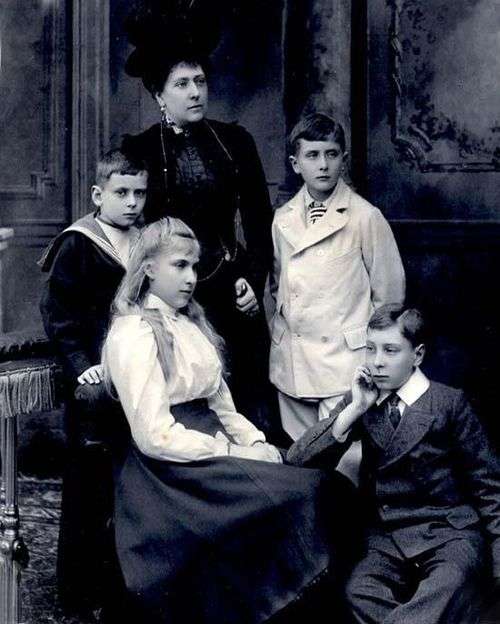 |
| Picture | Name | Birth | Death | Notes[3] |
|---|---|---|---|---|
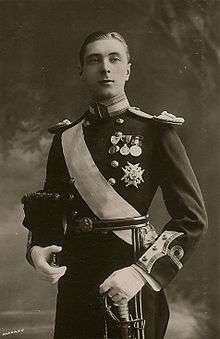 | Prince Alexander of Battenberg, later Sir Alexander Mountbatten, first Marquess of Carisbrooke | 23 November 1886 Windsor Castle, Berkshire, England | 23 February 1960 Kensington Palace, London | In 1917, Prince Alexander became Sir Alexander Mountbatten. On 7 November 1917, he was created Marquess of Carisbrooke, Earl of Berkhampsted and Viscount Launceston. Married 1917 Lady Irene Denison (1890–1956) and had issue (1 daughter): Lady Iris Mountbatten (1920–1982). |
 | Princess Victoria Eugènie of Battenberg, later Queen of Spain | 24 October 1887 Balmoral Castle, Aberdeenshire Scotland | 15 April 1969 Lausanne, Switzerland | Married in 1906 King Alfonso XIII of Spain (1886–1931) and had issue (5 sons, 2 daughters): Alfonso, Prince of Asturias (1907–1938), Infante Jaime, Duke of Segovia (1908–1975), Infanta Beatriz (1909–2002), Prince Fernando (stillborn 1910), Infanta Maria Cristina (1911–1996), Infante Juan, Count of Barcelona (1913–1993) — heir-apparent and father of King Juan Carlos I, and Infante Gonzalo (1914–1934) — a haemophiliac who died from bleeding after a car crash |
 | Prince Leopold of Battenberg, later Lord Leopold Mountbatten | 21 May 1889 Windsor Castle, Berkshire, England | 23 April 1922 Kensington Palace, London | As with his elder brother, he relinquished his title of Prince of Battenberg and the style His Highness and became Sir Leopold Mountbatten, by virtue of his being a Knight Grand Cross of the Royal Victorian Order. Under a further Royal Warrant in September 1917 he was granted the style and precedence of the younger son of a Marquess, and became Lord Leopold Mountbatten. He suffered from haemophilia; died unmarried and without issue after a knee operation. |
| | Prince Maurice of Battenberg | 3 October 1891 Balmoral Castle, Aberdeenshire, Scotland | 27 October 1914 Ypres, Belgium | Killed in action during World War I. He was the last grandchild of Queen Victoria and Prince Albert. |
See also
- Grandchildren of George V and Mary
- List of coupled cousins
- Royal descendants of Queen Victoria and King Christian IX
- Queen Victoria
References
- ↑ Elizabeth Longford, The Oxford Book of Royal Anecdotes, 1989 (ISBN 0-19-214153-8), pages 368-369
- 1 2 3 Whitaker's Almanack, 1900, Facsimile Reprint 1999 (ISBN 0-11-702247-0), page 86
- 1 2 3 4 5 6 7 8 9 Whitaker's Almanack, 1999, Standard Edition, The Stationery Office, London, 1998, (ISBN 0-11-702240-3), pages 127–129
- ↑ King, Greg Twilight of Splendor: The Court of Queen Victoria in Her Diamond Jubilee Year (John Wiley & Sons, 2007) pg. 46
- 1 2 3 King, pg. 46
- 1 2 3 4 King, pg. 47
- ↑ Pakula, Hannah An Uncommon Woman: The Empress Frederick: Daughter of Queen Victoria, Wife of the Crown Prince of Prussia, Mother of Kaiser Wilhelm (Simon & Schuster, 1995), pgs. 593 & 594
- ↑ King, pg. 61
- ↑ Whitaker's Almanack, 1993, Concise Edition, (ISBN 0-85021-232-4), pages 134–136
- ↑ Dunea, George (1969). "Porphyria Variegata, A Disease of Kings" (PDF). The Chicago Medical School Quarterly. 28 (12).
- ↑ "Yvonne's Royalty Home Page: Royal Christenings". Users.uniserve.com. Retrieved 2011-12-27.
- ↑ Marlene A. Eilers, Queen Victoria's Descendants, 1987, Genealogical Publishing Company, p. 205
Sources and external links
- Paul Theroff's An Online Gotha
- Eilers, Marlene A., Queen Victoria's Descendants, Baltimore, Maryland: Genealogical Publishing Co.
- Descendants of Queen Victoria of Great Britain and Ireland, 1840-1945, "European Royalty during World War II" (retrieved 3 January 2010)
- Croft, Christina Queen Victoria's Granddaughters 1860-1918, October 2013, ISBN 1492905542